Educational Technology & Delivery Methods
VerifiedAdded on 2020/02/03
|20
|6193
|62
Literature Review
AI Summary
This assignment examines the role of educational technology in enhancing learning experiences. It emphasizes adopting modern technologies to understand students' needs, employing diverse teaching strategies, and leveraging assessments like examinations to improve skill development and help students achieve their goals. The document also delves into relevant theories and frameworks from educational psychology.
Contribute Materials
Your contribution can guide someone’s learning journey. Share your
documents today.
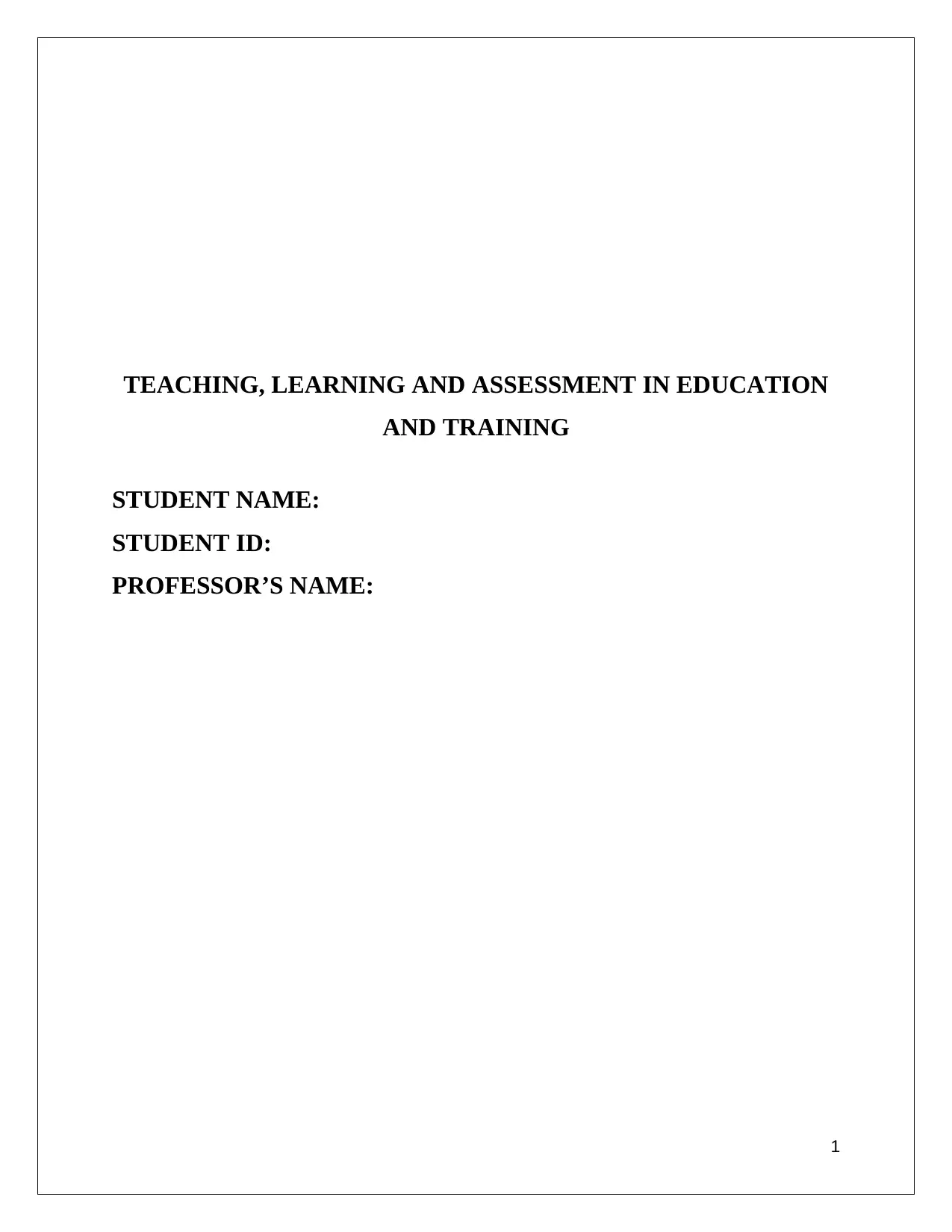
TEACHING, LEARNING AND ASSESSMENT IN EDUCATION
AND TRAINING
STUDENT NAME:
STUDENT ID:
PROFESSOR’S NAME:
1
AND TRAINING
STUDENT NAME:
STUDENT ID:
PROFESSOR’S NAME:
1
Secure Best Marks with AI Grader
Need help grading? Try our AI Grader for instant feedback on your assignments.
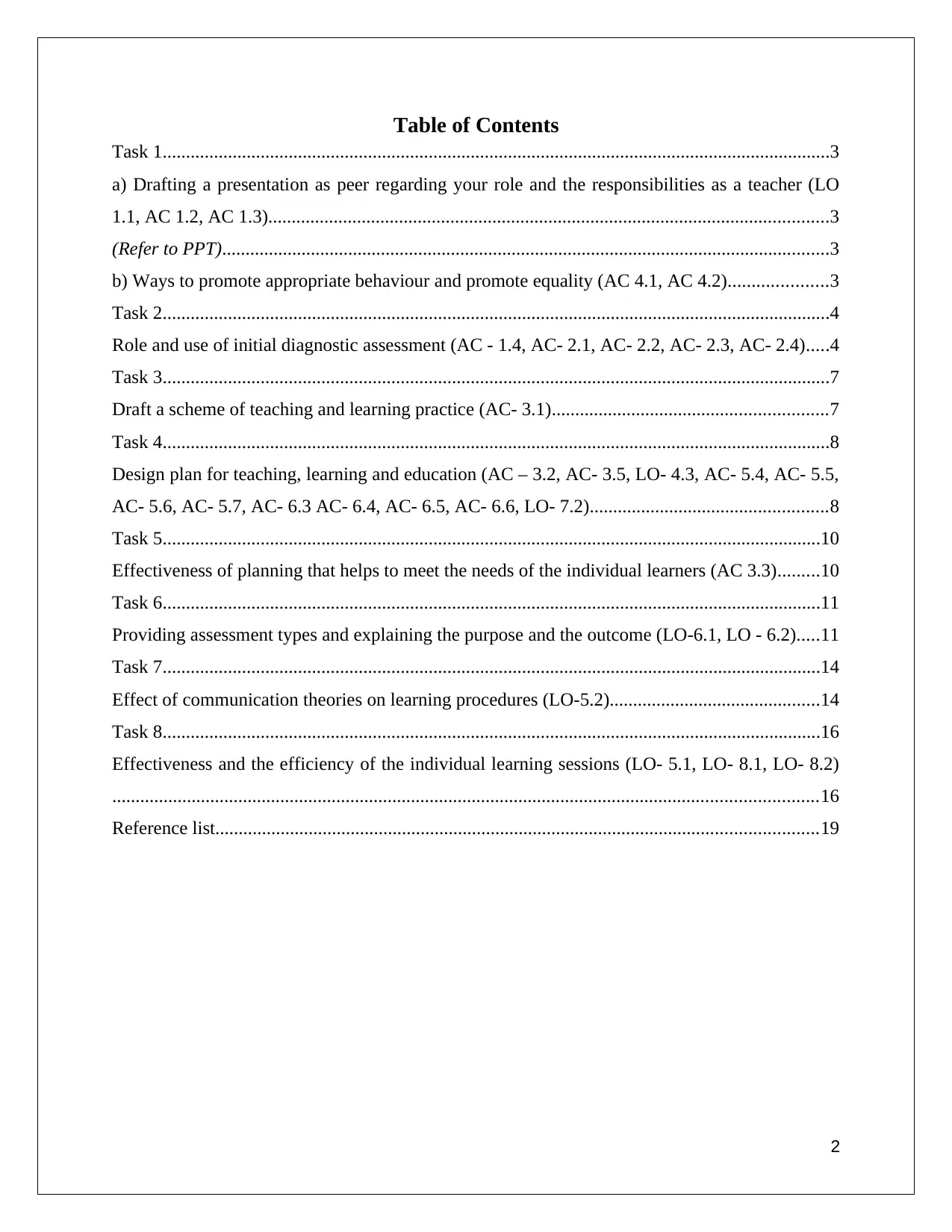
Table of Contents
Task 1...............................................................................................................................................3
a) Drafting a presentation as peer regarding your role and the responsibilities as a teacher (LO
1.1, AC 1.2, AC 1.3)........................................................................................................................3
(Refer to PPT)..................................................................................................................................3
b) Ways to promote appropriate behaviour and promote equality (AC 4.1, AC 4.2).....................3
Task 2...............................................................................................................................................4
Role and use of initial diagnostic assessment (AC - 1.4, AC- 2.1, AC- 2.2, AC- 2.3, AC- 2.4).....4
Task 3...............................................................................................................................................7
Draft a scheme of teaching and learning practice (AC- 3.1)...........................................................7
Task 4...............................................................................................................................................8
Design plan for teaching, learning and education (AC – 3.2, AC- 3.5, LO- 4.3, AC- 5.4, AC- 5.5,
AC- 5.6, AC- 5.7, AC- 6.3 AC- 6.4, AC- 6.5, AC- 6.6, LO- 7.2)...................................................8
Task 5.............................................................................................................................................10
Effectiveness of planning that helps to meet the needs of the individual learners (AC 3.3).........10
Task 6.............................................................................................................................................11
Providing assessment types and explaining the purpose and the outcome (LO-6.1, LO - 6.2).....11
Task 7.............................................................................................................................................14
Effect of communication theories on learning procedures (LO-5.2).............................................14
Task 8.............................................................................................................................................16
Effectiveness and the efficiency of the individual learning sessions (LO- 5.1, LO- 8.1, LO- 8.2)
.......................................................................................................................................................16
Reference list.................................................................................................................................19
2
Task 1...............................................................................................................................................3
a) Drafting a presentation as peer regarding your role and the responsibilities as a teacher (LO
1.1, AC 1.2, AC 1.3)........................................................................................................................3
(Refer to PPT)..................................................................................................................................3
b) Ways to promote appropriate behaviour and promote equality (AC 4.1, AC 4.2).....................3
Task 2...............................................................................................................................................4
Role and use of initial diagnostic assessment (AC - 1.4, AC- 2.1, AC- 2.2, AC- 2.3, AC- 2.4).....4
Task 3...............................................................................................................................................7
Draft a scheme of teaching and learning practice (AC- 3.1)...........................................................7
Task 4...............................................................................................................................................8
Design plan for teaching, learning and education (AC – 3.2, AC- 3.5, LO- 4.3, AC- 5.4, AC- 5.5,
AC- 5.6, AC- 5.7, AC- 6.3 AC- 6.4, AC- 6.5, AC- 6.6, LO- 7.2)...................................................8
Task 5.............................................................................................................................................10
Effectiveness of planning that helps to meet the needs of the individual learners (AC 3.3).........10
Task 6.............................................................................................................................................11
Providing assessment types and explaining the purpose and the outcome (LO-6.1, LO - 6.2).....11
Task 7.............................................................................................................................................14
Effect of communication theories on learning procedures (LO-5.2).............................................14
Task 8.............................................................................................................................................16
Effectiveness and the efficiency of the individual learning sessions (LO- 5.1, LO- 8.1, LO- 8.2)
.......................................................................................................................................................16
Reference list.................................................................................................................................19
2
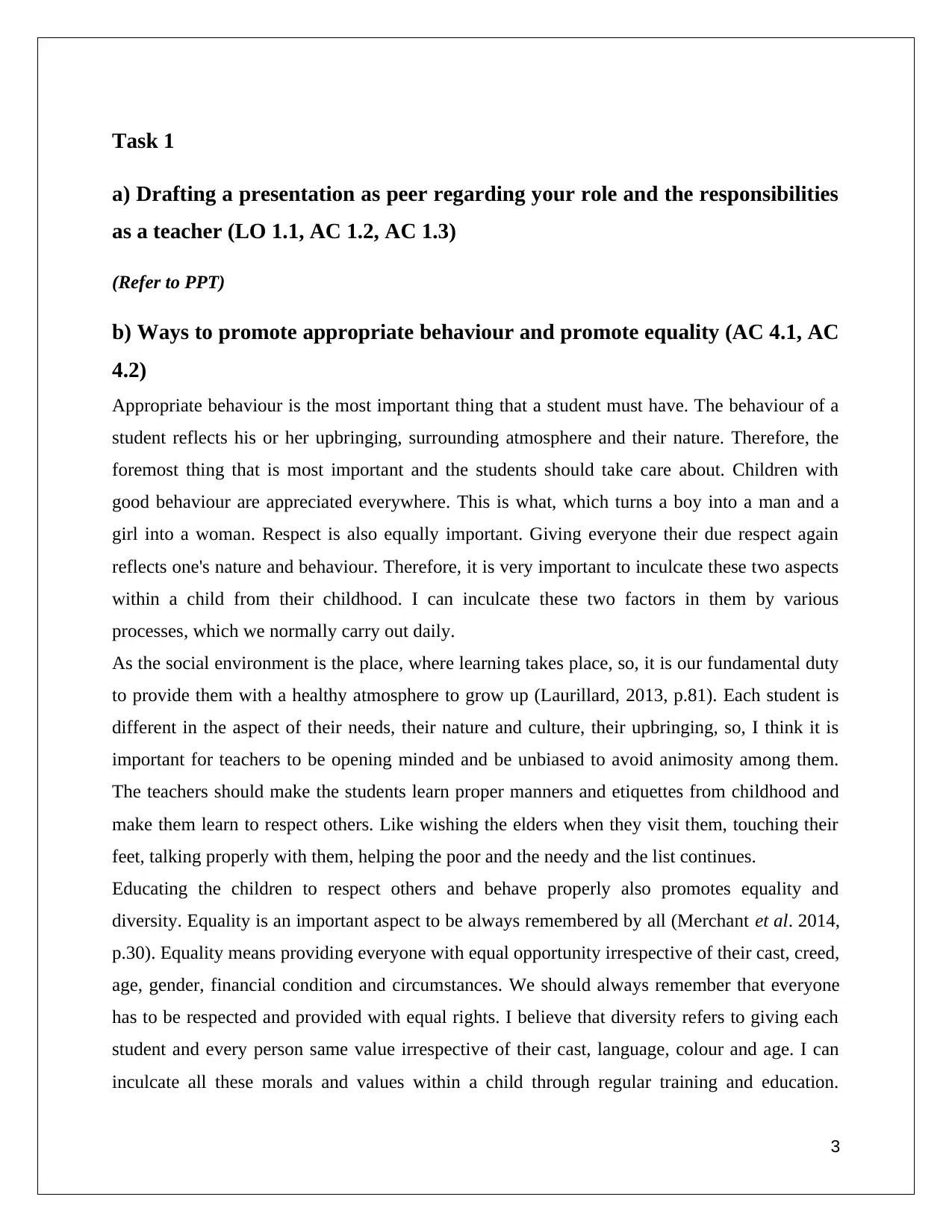
Task 1
a) Drafting a presentation as peer regarding your role and the responsibilities
as a teacher (LO 1.1, AC 1.2, AC 1.3)
(Refer to PPT)
b) Ways to promote appropriate behaviour and promote equality (AC 4.1, AC
4.2)
Appropriate behaviour is the most important thing that a student must have. The behaviour of a
student reflects his or her upbringing, surrounding atmosphere and their nature. Therefore, the
foremost thing that is most important and the students should take care about. Children with
good behaviour are appreciated everywhere. This is what, which turns a boy into a man and a
girl into a woman. Respect is also equally important. Giving everyone their due respect again
reflects one's nature and behaviour. Therefore, it is very important to inculcate these two aspects
within a child from their childhood. I can inculcate these two factors in them by various
processes, which we normally carry out daily.
As the social environment is the place, where learning takes place, so, it is our fundamental duty
to provide them with a healthy atmosphere to grow up (Laurillard, 2013, p.81). Each student is
different in the aspect of their needs, their nature and culture, their upbringing, so, I think it is
important for teachers to be opening minded and be unbiased to avoid animosity among them.
The teachers should make the students learn proper manners and etiquettes from childhood and
make them learn to respect others. Like wishing the elders when they visit them, touching their
feet, talking properly with them, helping the poor and the needy and the list continues.
Educating the children to respect others and behave properly also promotes equality and
diversity. Equality is an important aspect to be always remembered by all (Merchant et al. 2014,
p.30). Equality means providing everyone with equal opportunity irrespective of their cast, creed,
age, gender, financial condition and circumstances. We should always remember that everyone
has to be respected and provided with equal rights. I believe that diversity refers to giving each
student and every person same value irrespective of their cast, language, colour and age. I can
inculcate all these morals and values within a child through regular training and education.
3
a) Drafting a presentation as peer regarding your role and the responsibilities
as a teacher (LO 1.1, AC 1.2, AC 1.3)
(Refer to PPT)
b) Ways to promote appropriate behaviour and promote equality (AC 4.1, AC
4.2)
Appropriate behaviour is the most important thing that a student must have. The behaviour of a
student reflects his or her upbringing, surrounding atmosphere and their nature. Therefore, the
foremost thing that is most important and the students should take care about. Children with
good behaviour are appreciated everywhere. This is what, which turns a boy into a man and a
girl into a woman. Respect is also equally important. Giving everyone their due respect again
reflects one's nature and behaviour. Therefore, it is very important to inculcate these two aspects
within a child from their childhood. I can inculcate these two factors in them by various
processes, which we normally carry out daily.
As the social environment is the place, where learning takes place, so, it is our fundamental duty
to provide them with a healthy atmosphere to grow up (Laurillard, 2013, p.81). Each student is
different in the aspect of their needs, their nature and culture, their upbringing, so, I think it is
important for teachers to be opening minded and be unbiased to avoid animosity among them.
The teachers should make the students learn proper manners and etiquettes from childhood and
make them learn to respect others. Like wishing the elders when they visit them, touching their
feet, talking properly with them, helping the poor and the needy and the list continues.
Educating the children to respect others and behave properly also promotes equality and
diversity. Equality is an important aspect to be always remembered by all (Merchant et al. 2014,
p.30). Equality means providing everyone with equal opportunity irrespective of their cast, creed,
age, gender, financial condition and circumstances. We should always remember that everyone
has to be respected and provided with equal rights. I believe that diversity refers to giving each
student and every person same value irrespective of their cast, language, colour and age. I can
inculcate all these morals and values within a child through regular training and education.
3
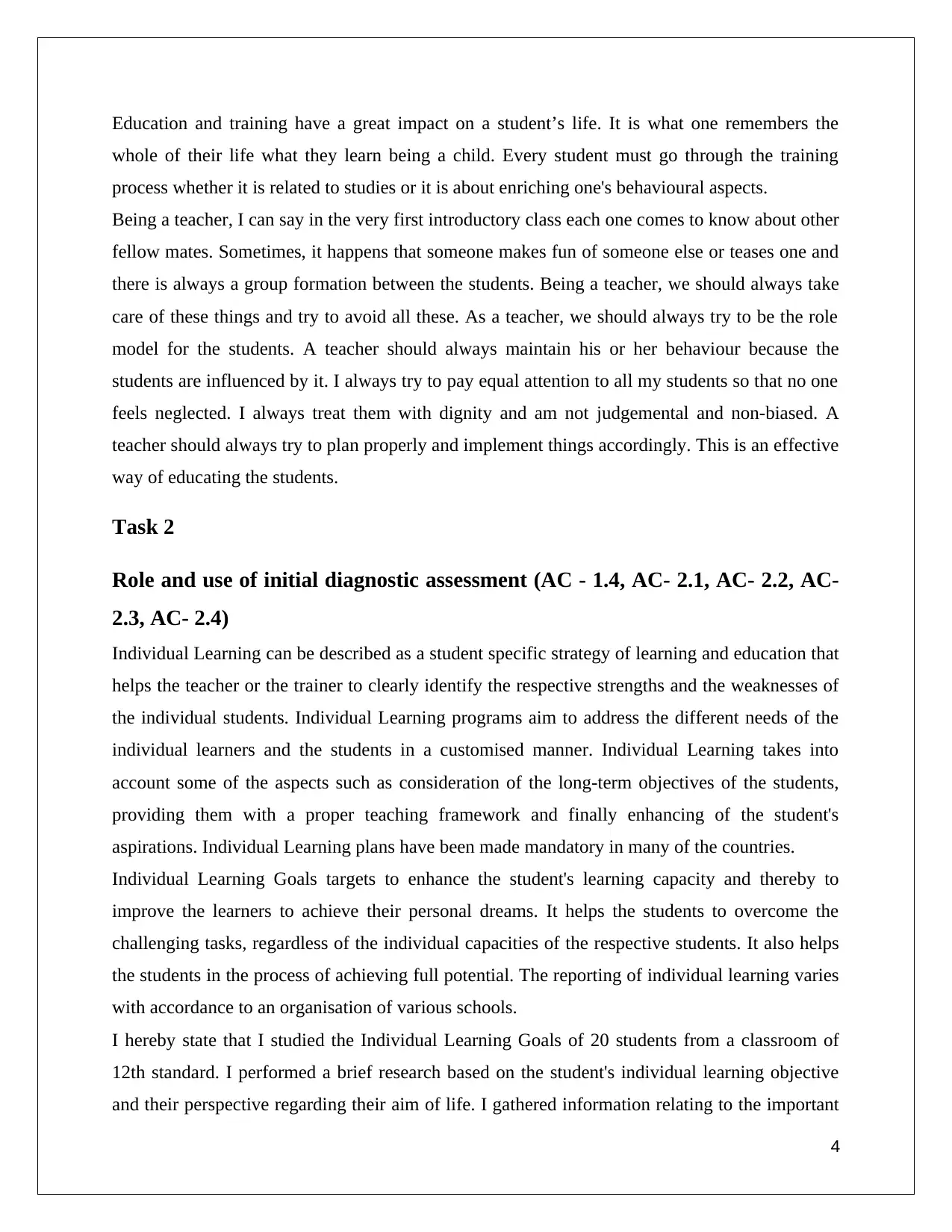
Education and training have a great impact on a student’s life. It is what one remembers the
whole of their life what they learn being a child. Every student must go through the training
process whether it is related to studies or it is about enriching one's behavioural aspects.
Being a teacher, I can say in the very first introductory class each one comes to know about other
fellow mates. Sometimes, it happens that someone makes fun of someone else or teases one and
there is always a group formation between the students. Being a teacher, we should always take
care of these things and try to avoid all these. As a teacher, we should always try to be the role
model for the students. A teacher should always maintain his or her behaviour because the
students are influenced by it. I always try to pay equal attention to all my students so that no one
feels neglected. I always treat them with dignity and am not judgemental and non-biased. A
teacher should always try to plan properly and implement things accordingly. This is an effective
way of educating the students.
Task 2
Role and use of initial diagnostic assessment (AC - 1.4, AC- 2.1, AC- 2.2, AC-
2.3, AC- 2.4)
Individual Learning can be described as a student specific strategy of learning and education that
helps the teacher or the trainer to clearly identify the respective strengths and the weaknesses of
the individual students. Individual Learning programs aim to address the different needs of the
individual learners and the students in a customised manner. Individual Learning takes into
account some of the aspects such as consideration of the long-term objectives of the students,
providing them with a proper teaching framework and finally enhancing of the student's
aspirations. Individual Learning plans have been made mandatory in many of the countries.
Individual Learning Goals targets to enhance the student's learning capacity and thereby to
improve the learners to achieve their personal dreams. It helps the students to overcome the
challenging tasks, regardless of the individual capacities of the respective students. It also helps
the students in the process of achieving full potential. The reporting of individual learning varies
with accordance to an organisation of various schools.
I hereby state that I studied the Individual Learning Goals of 20 students from a classroom of
12th standard. I performed a brief research based on the student's individual learning objective
and their perspective regarding their aim of life. I gathered information relating to the important
4
whole of their life what they learn being a child. Every student must go through the training
process whether it is related to studies or it is about enriching one's behavioural aspects.
Being a teacher, I can say in the very first introductory class each one comes to know about other
fellow mates. Sometimes, it happens that someone makes fun of someone else or teases one and
there is always a group formation between the students. Being a teacher, we should always take
care of these things and try to avoid all these. As a teacher, we should always try to be the role
model for the students. A teacher should always maintain his or her behaviour because the
students are influenced by it. I always try to pay equal attention to all my students so that no one
feels neglected. I always treat them with dignity and am not judgemental and non-biased. A
teacher should always try to plan properly and implement things accordingly. This is an effective
way of educating the students.
Task 2
Role and use of initial diagnostic assessment (AC - 1.4, AC- 2.1, AC- 2.2, AC-
2.3, AC- 2.4)
Individual Learning can be described as a student specific strategy of learning and education that
helps the teacher or the trainer to clearly identify the respective strengths and the weaknesses of
the individual students. Individual Learning programs aim to address the different needs of the
individual learners and the students in a customised manner. Individual Learning takes into
account some of the aspects such as consideration of the long-term objectives of the students,
providing them with a proper teaching framework and finally enhancing of the student's
aspirations. Individual Learning plans have been made mandatory in many of the countries.
Individual Learning Goals targets to enhance the student's learning capacity and thereby to
improve the learners to achieve their personal dreams. It helps the students to overcome the
challenging tasks, regardless of the individual capacities of the respective students. It also helps
the students in the process of achieving full potential. The reporting of individual learning varies
with accordance to an organisation of various schools.
I hereby state that I studied the Individual Learning Goals of 20 students from a classroom of
12th standard. I performed a brief research based on the student's individual learning objective
and their perspective regarding their aim of life. I gathered information relating to the important
4
Secure Best Marks with AI Grader
Need help grading? Try our AI Grader for instant feedback on your assignments.
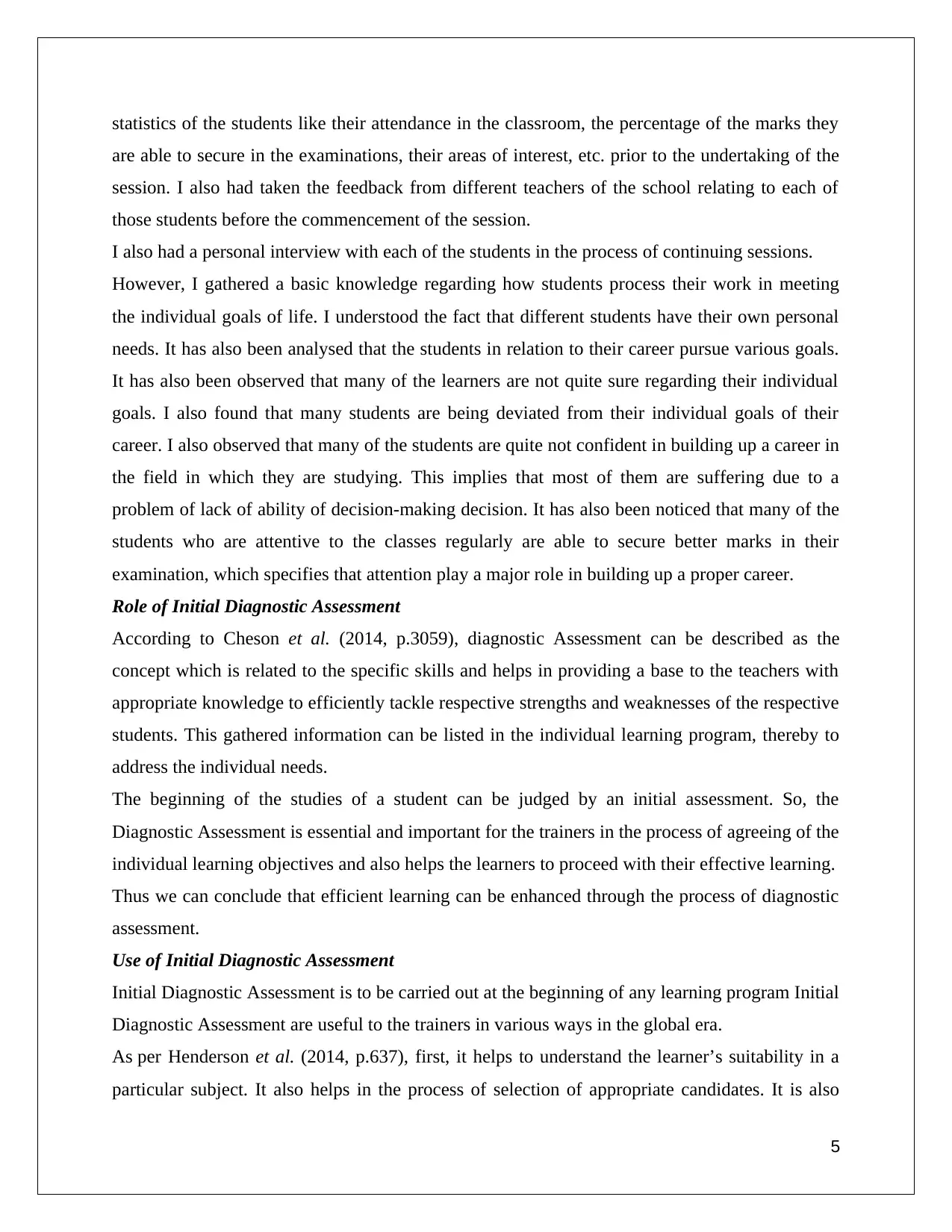
statistics of the students like their attendance in the classroom, the percentage of the marks they
are able to secure in the examinations, their areas of interest, etc. prior to the undertaking of the
session. I also had taken the feedback from different teachers of the school relating to each of
those students before the commencement of the session.
I also had a personal interview with each of the students in the process of continuing sessions.
However, I gathered a basic knowledge regarding how students process their work in meeting
the individual goals of life. I understood the fact that different students have their own personal
needs. It has also been analysed that the students in relation to their career pursue various goals.
It has also been observed that many of the learners are not quite sure regarding their individual
goals. I also found that many students are being deviated from their individual goals of their
career. I also observed that many of the students are quite not confident in building up a career in
the field in which they are studying. This implies that most of them are suffering due to a
problem of lack of ability of decision-making decision. It has also been noticed that many of the
students who are attentive to the classes regularly are able to secure better marks in their
examination, which specifies that attention play a major role in building up a proper career.
Role of Initial Diagnostic Assessment
According to Cheson et al. (2014, p.3059), diagnostic Assessment can be described as the
concept which is related to the specific skills and helps in providing a base to the teachers with
appropriate knowledge to efficiently tackle respective strengths and weaknesses of the respective
students. This gathered information can be listed in the individual learning program, thereby to
address the individual needs.
The beginning of the studies of a student can be judged by an initial assessment. So, the
Diagnostic Assessment is essential and important for the trainers in the process of agreeing of the
individual learning objectives and also helps the learners to proceed with their effective learning.
Thus we can conclude that efficient learning can be enhanced through the process of diagnostic
assessment.
Use of Initial Diagnostic Assessment
Initial Diagnostic Assessment is to be carried out at the beginning of any learning program Initial
Diagnostic Assessment are useful to the trainers in various ways in the global era.
As per Henderson et al. (2014, p.637), first, it helps to understand the learner’s suitability in a
particular subject. It also helps in the process of selection of appropriate candidates. It is also
5
are able to secure in the examinations, their areas of interest, etc. prior to the undertaking of the
session. I also had taken the feedback from different teachers of the school relating to each of
those students before the commencement of the session.
I also had a personal interview with each of the students in the process of continuing sessions.
However, I gathered a basic knowledge regarding how students process their work in meeting
the individual goals of life. I understood the fact that different students have their own personal
needs. It has also been analysed that the students in relation to their career pursue various goals.
It has also been observed that many of the learners are not quite sure regarding their individual
goals. I also found that many students are being deviated from their individual goals of their
career. I also observed that many of the students are quite not confident in building up a career in
the field in which they are studying. This implies that most of them are suffering due to a
problem of lack of ability of decision-making decision. It has also been noticed that many of the
students who are attentive to the classes regularly are able to secure better marks in their
examination, which specifies that attention play a major role in building up a proper career.
Role of Initial Diagnostic Assessment
According to Cheson et al. (2014, p.3059), diagnostic Assessment can be described as the
concept which is related to the specific skills and helps in providing a base to the teachers with
appropriate knowledge to efficiently tackle respective strengths and weaknesses of the respective
students. This gathered information can be listed in the individual learning program, thereby to
address the individual needs.
The beginning of the studies of a student can be judged by an initial assessment. So, the
Diagnostic Assessment is essential and important for the trainers in the process of agreeing of the
individual learning objectives and also helps the learners to proceed with their effective learning.
Thus we can conclude that efficient learning can be enhanced through the process of diagnostic
assessment.
Use of Initial Diagnostic Assessment
Initial Diagnostic Assessment is to be carried out at the beginning of any learning program Initial
Diagnostic Assessment are useful to the trainers in various ways in the global era.
As per Henderson et al. (2014, p.637), first, it helps to understand the learner’s suitability in a
particular subject. It also helps in the process of selection of appropriate candidates. It is also
5
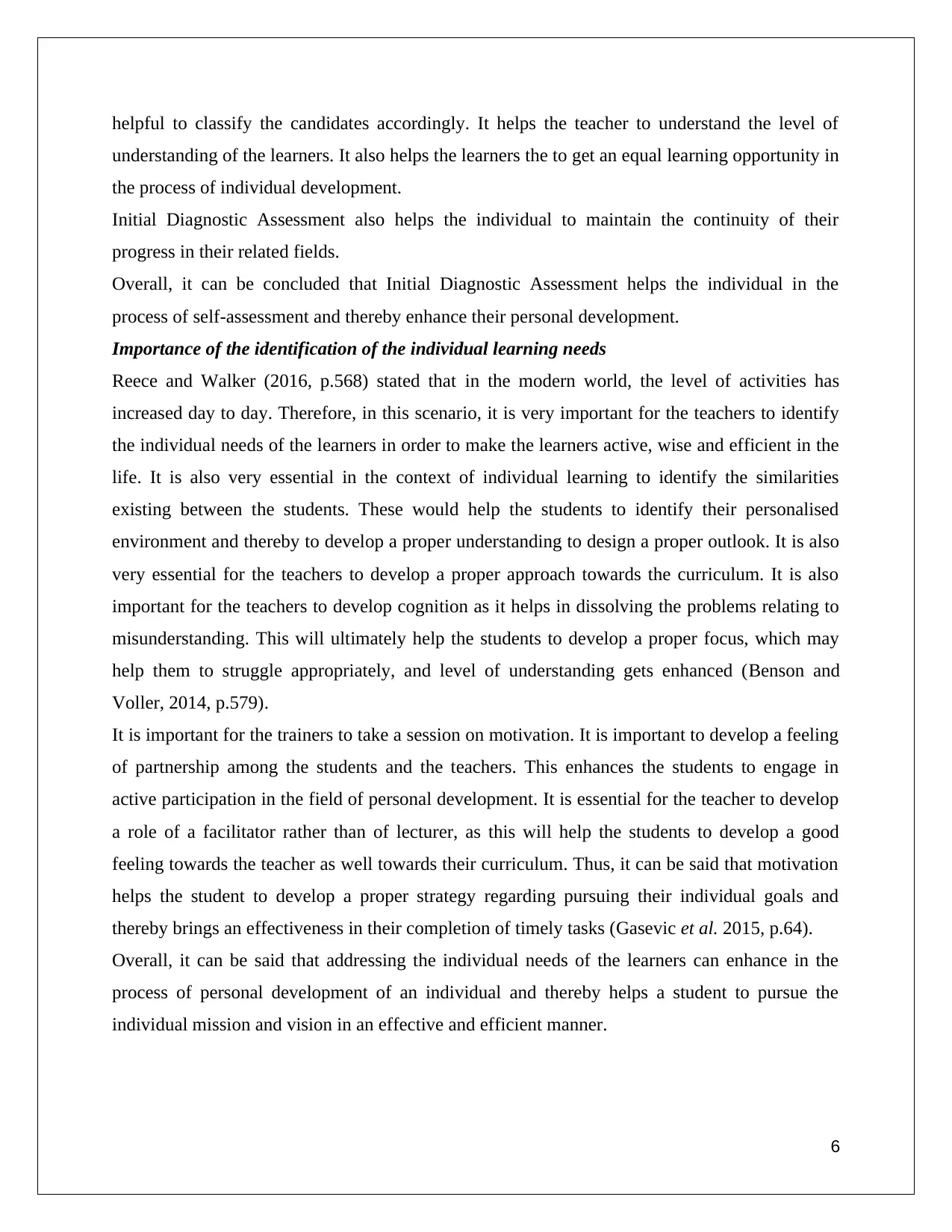
helpful to classify the candidates accordingly. It helps the teacher to understand the level of
understanding of the learners. It also helps the learners the to get an equal learning opportunity in
the process of individual development.
Initial Diagnostic Assessment also helps the individual to maintain the continuity of their
progress in their related fields.
Overall, it can be concluded that Initial Diagnostic Assessment helps the individual in the
process of self-assessment and thereby enhance their personal development.
Importance of the identification of the individual learning needs
Reece and Walker (2016, p.568) stated that in the modern world, the level of activities has
increased day to day. Therefore, in this scenario, it is very important for the teachers to identify
the individual needs of the learners in order to make the learners active, wise and efficient in the
life. It is also very essential in the context of individual learning to identify the similarities
existing between the students. These would help the students to identify their personalised
environment and thereby to develop a proper understanding to design a proper outlook. It is also
very essential for the teachers to develop a proper approach towards the curriculum. It is also
important for the teachers to develop cognition as it helps in dissolving the problems relating to
misunderstanding. This will ultimately help the students to develop a proper focus, which may
help them to struggle appropriately, and level of understanding gets enhanced (Benson and
Voller, 2014, p.579).
It is important for the trainers to take a session on motivation. It is important to develop a feeling
of partnership among the students and the teachers. This enhances the students to engage in
active participation in the field of personal development. It is essential for the teacher to develop
a role of a facilitator rather than of lecturer, as this will help the students to develop a good
feeling towards the teacher as well towards their curriculum. Thus, it can be said that motivation
helps the student to develop a proper strategy regarding pursuing their individual goals and
thereby brings an effectiveness in their completion of timely tasks (Gasevic et al. 2015, p.64).
Overall, it can be said that addressing the individual needs of the learners can enhance in the
process of personal development of an individual and thereby helps a student to pursue the
individual mission and vision in an effective and efficient manner.
6
understanding of the learners. It also helps the learners the to get an equal learning opportunity in
the process of individual development.
Initial Diagnostic Assessment also helps the individual to maintain the continuity of their
progress in their related fields.
Overall, it can be concluded that Initial Diagnostic Assessment helps the individual in the
process of self-assessment and thereby enhance their personal development.
Importance of the identification of the individual learning needs
Reece and Walker (2016, p.568) stated that in the modern world, the level of activities has
increased day to day. Therefore, in this scenario, it is very important for the teachers to identify
the individual needs of the learners in order to make the learners active, wise and efficient in the
life. It is also very essential in the context of individual learning to identify the similarities
existing between the students. These would help the students to identify their personalised
environment and thereby to develop a proper understanding to design a proper outlook. It is also
very essential for the teachers to develop a proper approach towards the curriculum. It is also
important for the teachers to develop cognition as it helps in dissolving the problems relating to
misunderstanding. This will ultimately help the students to develop a proper focus, which may
help them to struggle appropriately, and level of understanding gets enhanced (Benson and
Voller, 2014, p.579).
It is important for the trainers to take a session on motivation. It is important to develop a feeling
of partnership among the students and the teachers. This enhances the students to engage in
active participation in the field of personal development. It is essential for the teacher to develop
a role of a facilitator rather than of lecturer, as this will help the students to develop a good
feeling towards the teacher as well towards their curriculum. Thus, it can be said that motivation
helps the student to develop a proper strategy regarding pursuing their individual goals and
thereby brings an effectiveness in their completion of timely tasks (Gasevic et al. 2015, p.64).
Overall, it can be said that addressing the individual needs of the learners can enhance in the
process of personal development of an individual and thereby helps a student to pursue the
individual mission and vision in an effective and efficient manner.
6
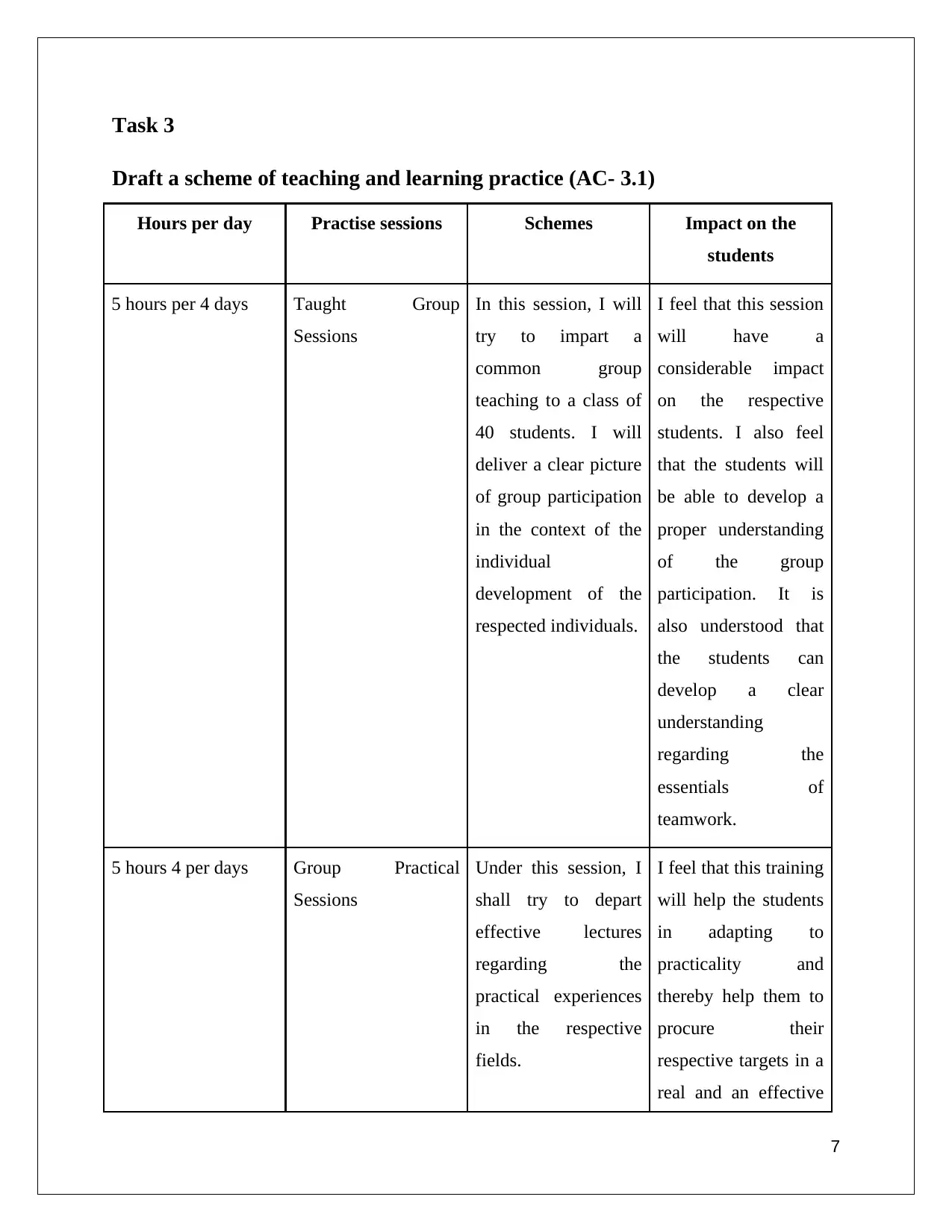
Task 3
Draft a scheme of teaching and learning practice (AC- 3.1)
Hours per day Practise sessions Schemes Impact on the
students
5 hours per 4 days Taught Group
Sessions
In this session, I will
try to impart a
common group
teaching to a class of
40 students. I will
deliver a clear picture
of group participation
in the context of the
individual
development of the
respected individuals.
I feel that this session
will have a
considerable impact
on the respective
students. I also feel
that the students will
be able to develop a
proper understanding
of the group
participation. It is
also understood that
the students can
develop a clear
understanding
regarding the
essentials of
teamwork.
5 hours 4 per days Group Practical
Sessions
Under this session, I
shall try to depart
effective lectures
regarding the
practical experiences
in the respective
fields.
I feel that this training
will help the students
in adapting to
practicality and
thereby help them to
procure their
respective targets in a
real and an effective
7
Draft a scheme of teaching and learning practice (AC- 3.1)
Hours per day Practise sessions Schemes Impact on the
students
5 hours per 4 days Taught Group
Sessions
In this session, I will
try to impart a
common group
teaching to a class of
40 students. I will
deliver a clear picture
of group participation
in the context of the
individual
development of the
respected individuals.
I feel that this session
will have a
considerable impact
on the respective
students. I also feel
that the students will
be able to develop a
proper understanding
of the group
participation. It is
also understood that
the students can
develop a clear
understanding
regarding the
essentials of
teamwork.
5 hours 4 per days Group Practical
Sessions
Under this session, I
shall try to depart
effective lectures
regarding the
practical experiences
in the respective
fields.
I feel that this training
will help the students
in adapting to
practicality and
thereby help them to
procure their
respective targets in a
real and an effective
7
Paraphrase This Document
Need a fresh take? Get an instant paraphrase of this document with our AI Paraphraser
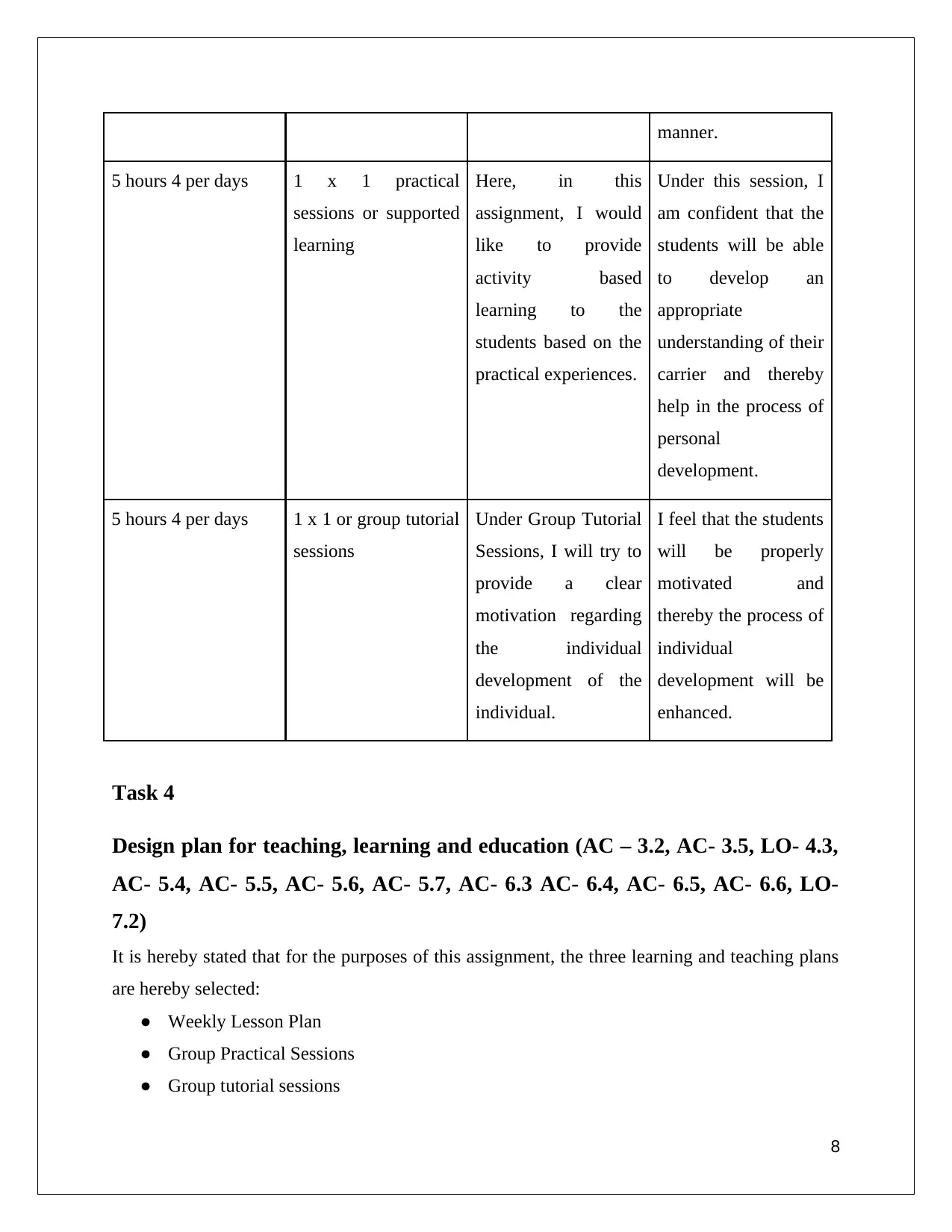
manner.
5 hours 4 per days 1 x 1 practical
sessions or supported
learning
Here, in this
assignment, I would
like to provide
activity based
learning to the
students based on the
practical experiences.
Under this session, I
am confident that the
students will be able
to develop an
appropriate
understanding of their
carrier and thereby
help in the process of
personal
development.
5 hours 4 per days 1 x 1 or group tutorial
sessions
Under Group Tutorial
Sessions, I will try to
provide a clear
motivation regarding
the individual
development of the
individual.
I feel that the students
will be properly
motivated and
thereby the process of
individual
development will be
enhanced.
Task 4
Design plan for teaching, learning and education (AC – 3.2, AC- 3.5, LO- 4.3,
AC- 5.4, AC- 5.5, AC- 5.6, AC- 5.7, AC- 6.3 AC- 6.4, AC- 6.5, AC- 6.6, LO-
7.2)
It is hereby stated that for the purposes of this assignment, the three learning and teaching plans
are hereby selected:
● Weekly Lesson Plan
● Group Practical Sessions
● Group tutorial sessions
8
5 hours 4 per days 1 x 1 practical
sessions or supported
learning
Here, in this
assignment, I would
like to provide
activity based
learning to the
students based on the
practical experiences.
Under this session, I
am confident that the
students will be able
to develop an
appropriate
understanding of their
carrier and thereby
help in the process of
personal
development.
5 hours 4 per days 1 x 1 or group tutorial
sessions
Under Group Tutorial
Sessions, I will try to
provide a clear
motivation regarding
the individual
development of the
individual.
I feel that the students
will be properly
motivated and
thereby the process of
individual
development will be
enhanced.
Task 4
Design plan for teaching, learning and education (AC – 3.2, AC- 3.5, LO- 4.3,
AC- 5.4, AC- 5.5, AC- 5.6, AC- 5.7, AC- 6.3 AC- 6.4, AC- 6.5, AC- 6.6, LO-
7.2)
It is hereby stated that for the purposes of this assignment, the three learning and teaching plans
are hereby selected:
● Weekly Lesson Plan
● Group Practical Sessions
● Group tutorial sessions
8
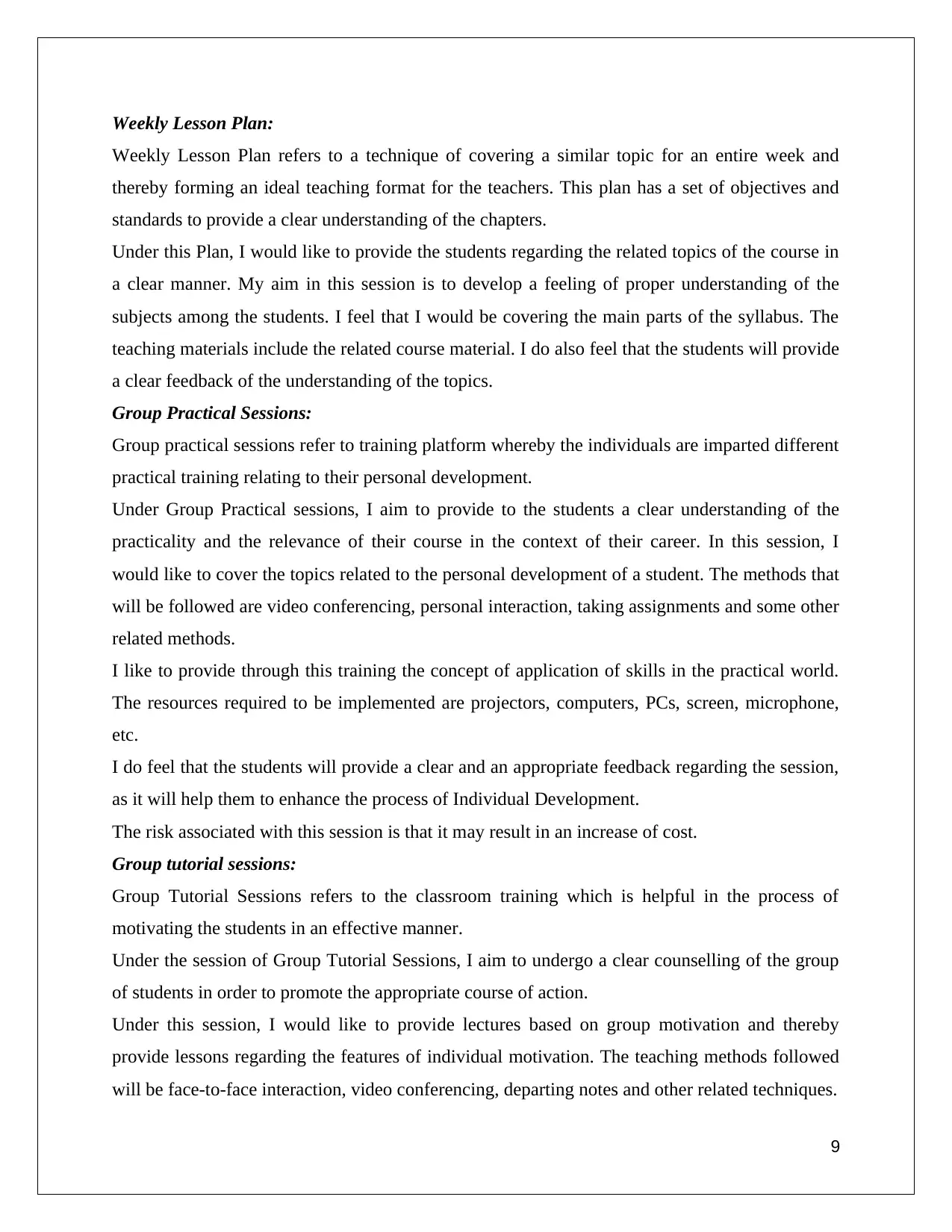
Weekly Lesson Plan:
Weekly Lesson Plan refers to a technique of covering a similar topic for an entire week and
thereby forming an ideal teaching format for the teachers. This plan has a set of objectives and
standards to provide a clear understanding of the chapters.
Under this Plan, I would like to provide the students regarding the related topics of the course in
a clear manner. My aim in this session is to develop a feeling of proper understanding of the
subjects among the students. I feel that I would be covering the main parts of the syllabus. The
teaching materials include the related course material. I do also feel that the students will provide
a clear feedback of the understanding of the topics.
Group Practical Sessions:
Group practical sessions refer to training platform whereby the individuals are imparted different
practical training relating to their personal development.
Under Group Practical sessions, I aim to provide to the students a clear understanding of the
practicality and the relevance of their course in the context of their career. In this session, I
would like to cover the topics related to the personal development of a student. The methods that
will be followed are video conferencing, personal interaction, taking assignments and some other
related methods.
I like to provide through this training the concept of application of skills in the practical world.
The resources required to be implemented are projectors, computers, PCs, screen, microphone,
etc.
I do feel that the students will provide a clear and an appropriate feedback regarding the session,
as it will help them to enhance the process of Individual Development.
The risk associated with this session is that it may result in an increase of cost.
Group tutorial sessions:
Group Tutorial Sessions refers to the classroom training which is helpful in the process of
motivating the students in an effective manner.
Under the session of Group Tutorial Sessions, I aim to undergo a clear counselling of the group
of students in order to promote the appropriate course of action.
Under this session, I would like to provide lectures based on group motivation and thereby
provide lessons regarding the features of individual motivation. The teaching methods followed
will be face-to-face interaction, video conferencing, departing notes and other related techniques.
9
Weekly Lesson Plan refers to a technique of covering a similar topic for an entire week and
thereby forming an ideal teaching format for the teachers. This plan has a set of objectives and
standards to provide a clear understanding of the chapters.
Under this Plan, I would like to provide the students regarding the related topics of the course in
a clear manner. My aim in this session is to develop a feeling of proper understanding of the
subjects among the students. I feel that I would be covering the main parts of the syllabus. The
teaching materials include the related course material. I do also feel that the students will provide
a clear feedback of the understanding of the topics.
Group Practical Sessions:
Group practical sessions refer to training platform whereby the individuals are imparted different
practical training relating to their personal development.
Under Group Practical sessions, I aim to provide to the students a clear understanding of the
practicality and the relevance of their course in the context of their career. In this session, I
would like to cover the topics related to the personal development of a student. The methods that
will be followed are video conferencing, personal interaction, taking assignments and some other
related methods.
I like to provide through this training the concept of application of skills in the practical world.
The resources required to be implemented are projectors, computers, PCs, screen, microphone,
etc.
I do feel that the students will provide a clear and an appropriate feedback regarding the session,
as it will help them to enhance the process of Individual Development.
The risk associated with this session is that it may result in an increase of cost.
Group tutorial sessions:
Group Tutorial Sessions refers to the classroom training which is helpful in the process of
motivating the students in an effective manner.
Under the session of Group Tutorial Sessions, I aim to undergo a clear counselling of the group
of students in order to promote the appropriate course of action.
Under this session, I would like to provide lectures based on group motivation and thereby
provide lessons regarding the features of individual motivation. The teaching methods followed
will be face-to-face interaction, video conferencing, departing notes and other related techniques.
9
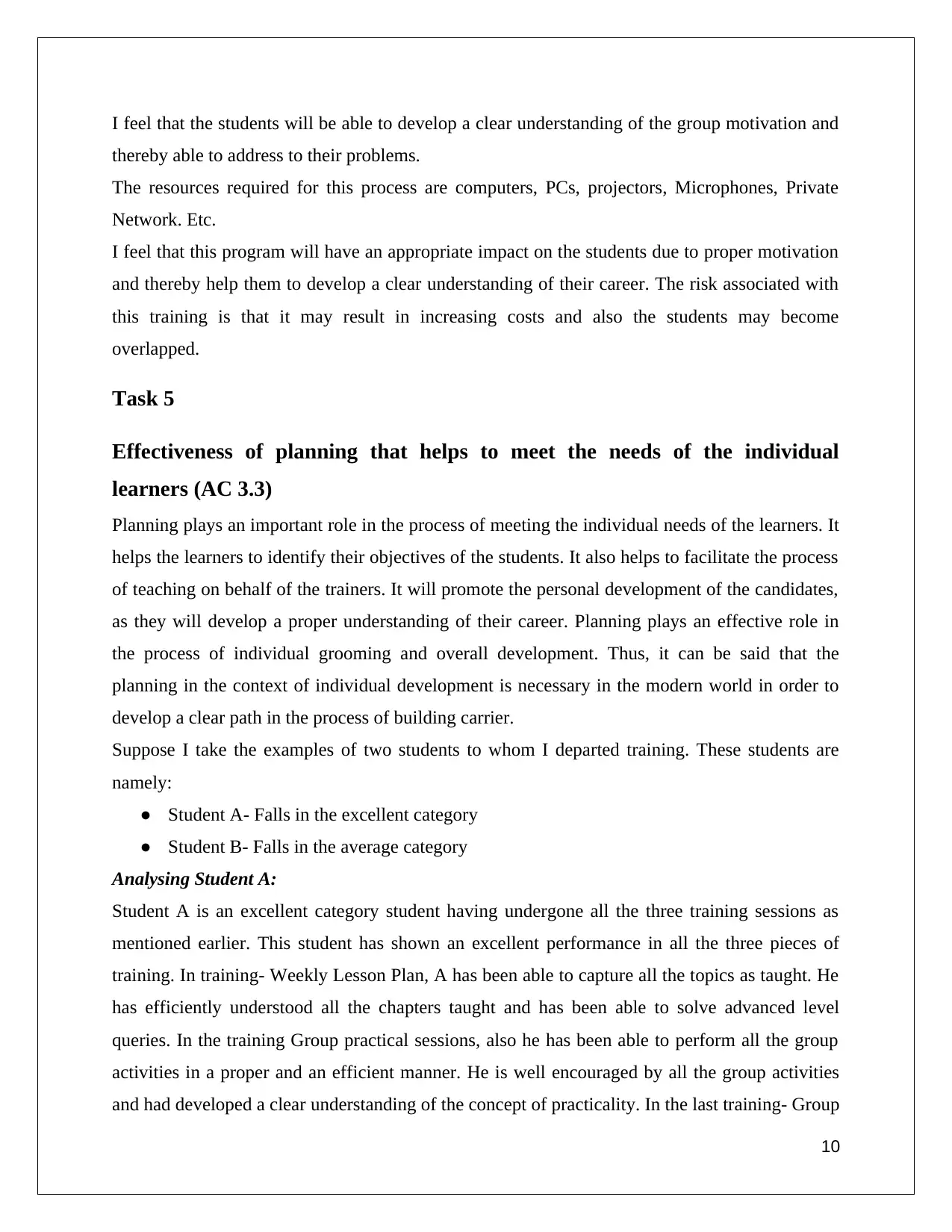
I feel that the students will be able to develop a clear understanding of the group motivation and
thereby able to address to their problems.
The resources required for this process are computers, PCs, projectors, Microphones, Private
Network. Etc.
I feel that this program will have an appropriate impact on the students due to proper motivation
and thereby help them to develop a clear understanding of their career. The risk associated with
this training is that it may result in increasing costs and also the students may become
overlapped.
Task 5
Effectiveness of planning that helps to meet the needs of the individual
learners (AC 3.3)
Planning plays an important role in the process of meeting the individual needs of the learners. It
helps the learners to identify their objectives of the students. It also helps to facilitate the process
of teaching on behalf of the trainers. It will promote the personal development of the candidates,
as they will develop a proper understanding of their career. Planning plays an effective role in
the process of individual grooming and overall development. Thus, it can be said that the
planning in the context of individual development is necessary in the modern world in order to
develop a clear path in the process of building carrier.
Suppose I take the examples of two students to whom I departed training. These students are
namely:
● Student A- Falls in the excellent category
● Student B- Falls in the average category
Analysing Student A:
Student A is an excellent category student having undergone all the three training sessions as
mentioned earlier. This student has shown an excellent performance in all the three pieces of
training. In training- Weekly Lesson Plan, A has been able to capture all the topics as taught. He
has efficiently understood all the chapters taught and has been able to solve advanced level
queries. In the training Group practical sessions, also he has been able to perform all the group
activities in a proper and an efficient manner. He is well encouraged by all the group activities
and had developed a clear understanding of the concept of practicality. In the last training- Group
10
thereby able to address to their problems.
The resources required for this process are computers, PCs, projectors, Microphones, Private
Network. Etc.
I feel that this program will have an appropriate impact on the students due to proper motivation
and thereby help them to develop a clear understanding of their career. The risk associated with
this training is that it may result in increasing costs and also the students may become
overlapped.
Task 5
Effectiveness of planning that helps to meet the needs of the individual
learners (AC 3.3)
Planning plays an important role in the process of meeting the individual needs of the learners. It
helps the learners to identify their objectives of the students. It also helps to facilitate the process
of teaching on behalf of the trainers. It will promote the personal development of the candidates,
as they will develop a proper understanding of their career. Planning plays an effective role in
the process of individual grooming and overall development. Thus, it can be said that the
planning in the context of individual development is necessary in the modern world in order to
develop a clear path in the process of building carrier.
Suppose I take the examples of two students to whom I departed training. These students are
namely:
● Student A- Falls in the excellent category
● Student B- Falls in the average category
Analysing Student A:
Student A is an excellent category student having undergone all the three training sessions as
mentioned earlier. This student has shown an excellent performance in all the three pieces of
training. In training- Weekly Lesson Plan, A has been able to capture all the topics as taught. He
has efficiently understood all the chapters taught and has been able to solve advanced level
queries. In the training Group practical sessions, also he has been able to perform all the group
activities in a proper and an efficient manner. He is well encouraged by all the group activities
and had developed a clear understanding of the concept of practicality. In the last training- Group
10
Secure Best Marks with AI Grader
Need help grading? Try our AI Grader for instant feedback on your assignments.
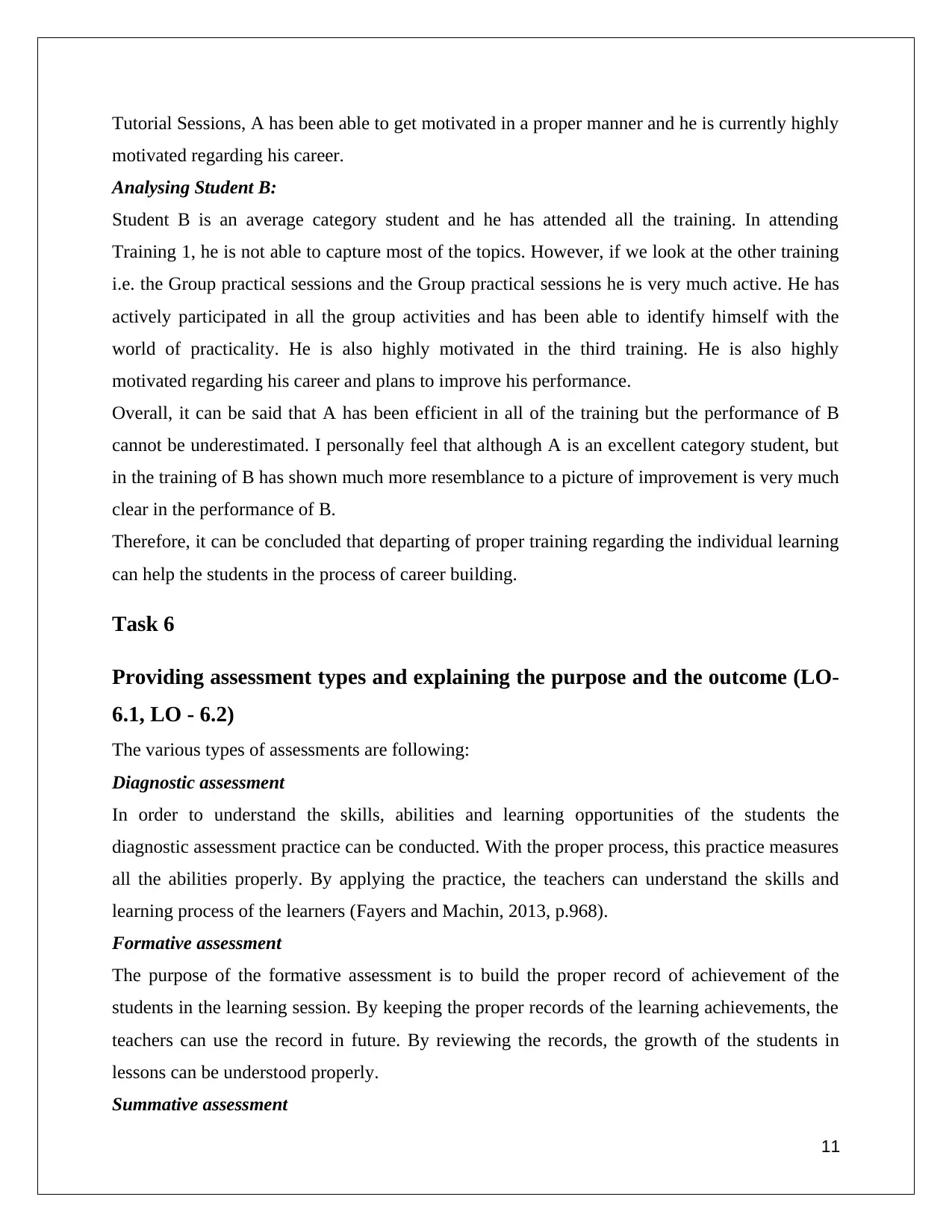
Tutorial Sessions, A has been able to get motivated in a proper manner and he is currently highly
motivated regarding his career.
Analysing Student B:
Student B is an average category student and he has attended all the training. In attending
Training 1, he is not able to capture most of the topics. However, if we look at the other training
i.e. the Group practical sessions and the Group practical sessions he is very much active. He has
actively participated in all the group activities and has been able to identify himself with the
world of practicality. He is also highly motivated in the third training. He is also highly
motivated regarding his career and plans to improve his performance.
Overall, it can be said that A has been efficient in all of the training but the performance of B
cannot be underestimated. I personally feel that although A is an excellent category student, but
in the training of B has shown much more resemblance to a picture of improvement is very much
clear in the performance of B.
Therefore, it can be concluded that departing of proper training regarding the individual learning
can help the students in the process of career building.
Task 6
Providing assessment types and explaining the purpose and the outcome (LO-
6.1, LO - 6.2)
The various types of assessments are following:
Diagnostic assessment
In order to understand the skills, abilities and learning opportunities of the students the
diagnostic assessment practice can be conducted. With the proper process, this practice measures
all the abilities properly. By applying the practice, the teachers can understand the skills and
learning process of the learners (Fayers and Machin, 2013, p.968).
Formative assessment
The purpose of the formative assessment is to build the proper record of achievement of the
students in the learning session. By keeping the proper records of the learning achievements, the
teachers can use the record in future. By reviewing the records, the growth of the students in
lessons can be understood properly.
Summative assessment
11
motivated regarding his career.
Analysing Student B:
Student B is an average category student and he has attended all the training. In attending
Training 1, he is not able to capture most of the topics. However, if we look at the other training
i.e. the Group practical sessions and the Group practical sessions he is very much active. He has
actively participated in all the group activities and has been able to identify himself with the
world of practicality. He is also highly motivated in the third training. He is also highly
motivated regarding his career and plans to improve his performance.
Overall, it can be said that A has been efficient in all of the training but the performance of B
cannot be underestimated. I personally feel that although A is an excellent category student, but
in the training of B has shown much more resemblance to a picture of improvement is very much
clear in the performance of B.
Therefore, it can be concluded that departing of proper training regarding the individual learning
can help the students in the process of career building.
Task 6
Providing assessment types and explaining the purpose and the outcome (LO-
6.1, LO - 6.2)
The various types of assessments are following:
Diagnostic assessment
In order to understand the skills, abilities and learning opportunities of the students the
diagnostic assessment practice can be conducted. With the proper process, this practice measures
all the abilities properly. By applying the practice, the teachers can understand the skills and
learning process of the learners (Fayers and Machin, 2013, p.968).
Formative assessment
The purpose of the formative assessment is to build the proper record of achievement of the
students in the learning session. By keeping the proper records of the learning achievements, the
teachers can use the record in future. By reviewing the records, the growth of the students in
lessons can be understood properly.
Summative assessment
11
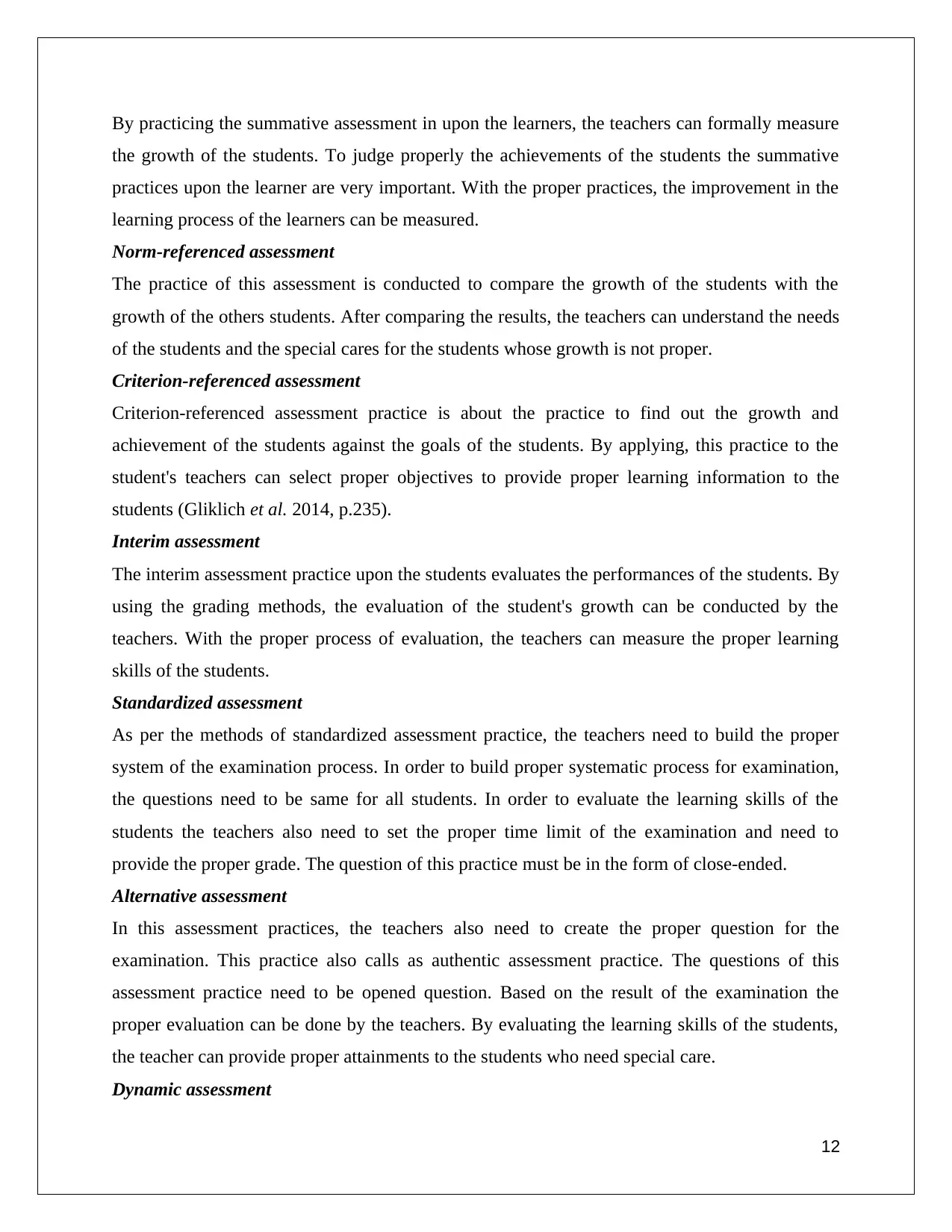
By practicing the summative assessment in upon the learners, the teachers can formally measure
the growth of the students. To judge properly the achievements of the students the summative
practices upon the learner are very important. With the proper practices, the improvement in the
learning process of the learners can be measured.
Norm-referenced assessment
The practice of this assessment is conducted to compare the growth of the students with the
growth of the others students. After comparing the results, the teachers can understand the needs
of the students and the special cares for the students whose growth is not proper.
Criterion-referenced assessment
Criterion-referenced assessment practice is about the practice to find out the growth and
achievement of the students against the goals of the students. By applying, this practice to the
student's teachers can select proper objectives to provide proper learning information to the
students (Gliklich et al. 2014, p.235).
Interim assessment
The interim assessment practice upon the students evaluates the performances of the students. By
using the grading methods, the evaluation of the student's growth can be conducted by the
teachers. With the proper process of evaluation, the teachers can measure the proper learning
skills of the students.
Standardized assessment
As per the methods of standardized assessment practice, the teachers need to build the proper
system of the examination process. In order to build proper systematic process for examination,
the questions need to be same for all students. In order to evaluate the learning skills of the
students the teachers also need to set the proper time limit of the examination and need to
provide the proper grade. The question of this practice must be in the form of close-ended.
Alternative assessment
In this assessment practices, the teachers also need to create the proper question for the
examination. This practice also calls as authentic assessment practice. The questions of this
assessment practice need to be opened question. Based on the result of the examination the
proper evaluation can be done by the teachers. By evaluating the learning skills of the students,
the teacher can provide proper attainments to the students who need special care.
Dynamic assessment
12
the growth of the students. To judge properly the achievements of the students the summative
practices upon the learner are very important. With the proper practices, the improvement in the
learning process of the learners can be measured.
Norm-referenced assessment
The practice of this assessment is conducted to compare the growth of the students with the
growth of the others students. After comparing the results, the teachers can understand the needs
of the students and the special cares for the students whose growth is not proper.
Criterion-referenced assessment
Criterion-referenced assessment practice is about the practice to find out the growth and
achievement of the students against the goals of the students. By applying, this practice to the
student's teachers can select proper objectives to provide proper learning information to the
students (Gliklich et al. 2014, p.235).
Interim assessment
The interim assessment practice upon the students evaluates the performances of the students. By
using the grading methods, the evaluation of the student's growth can be conducted by the
teachers. With the proper process of evaluation, the teachers can measure the proper learning
skills of the students.
Standardized assessment
As per the methods of standardized assessment practice, the teachers need to build the proper
system of the examination process. In order to build proper systematic process for examination,
the questions need to be same for all students. In order to evaluate the learning skills of the
students the teachers also need to set the proper time limit of the examination and need to
provide the proper grade. The question of this practice must be in the form of close-ended.
Alternative assessment
In this assessment practices, the teachers also need to create the proper question for the
examination. This practice also calls as authentic assessment practice. The questions of this
assessment practice need to be opened question. Based on the result of the examination the
proper evaluation can be done by the teachers. By evaluating the learning skills of the students,
the teacher can provide proper attainments to the students who need special care.
Dynamic assessment
12

This assessment practice is conducted at the time of the achievement of the students in a
particular field or topic. Based on the performances of the students the teachers can measure their
skills and abilities. In order to divide the students into the perfect section, it is important for the
teachers to practice properly the dynamic assessment (Race, 2014, p.74).
Synoptic assessment
The practice of synoptic assessment encourages the students to learn properly and to participate
in the lessons properly. By applying this practice to students, the teachers can provide
encouragement to the students to collect proper knowledge and information for proper learning.
Taught group sessions
As per the methods of the taught group sessions, it is important for the teachers to teach every
student of the group properly in order to provide proper teaching to the students of the group
properly. In order to provide proper information to the students, it is important for the teacher to
practice the diagnostic assessment.
● By applying the diagnostic assessment upon the students of the group the teachers can
measure the ability of the students and can provide proper knowledge to the students
● In order to develop the skills and learning the ability of the student's diagnostic
assessment are important and it improves the skills of the students. In various educational
organisations around the world, this assessment has been used.
Group practical sessions
In the case of the group practical sessions, the standardized assessment practice is important to
measure the skills of the students.
● As the questions are close-ended, so the students can provide answers and can learn
properly. With the test process, the teachers also understand the present situation of the
students.
● In order to measure the learning outcomes of the students, various schools and
organisations applied this process to their students. The assessment is valid and sufficient
in order to improve the skills of the students. The Teachers also can provide proper
attentions to the students who need special care.
1 x 1 practical sessions or supported learning
13
particular field or topic. Based on the performances of the students the teachers can measure their
skills and abilities. In order to divide the students into the perfect section, it is important for the
teachers to practice properly the dynamic assessment (Race, 2014, p.74).
Synoptic assessment
The practice of synoptic assessment encourages the students to learn properly and to participate
in the lessons properly. By applying this practice to students, the teachers can provide
encouragement to the students to collect proper knowledge and information for proper learning.
Taught group sessions
As per the methods of the taught group sessions, it is important for the teachers to teach every
student of the group properly in order to provide proper teaching to the students of the group
properly. In order to provide proper information to the students, it is important for the teacher to
practice the diagnostic assessment.
● By applying the diagnostic assessment upon the students of the group the teachers can
measure the ability of the students and can provide proper knowledge to the students
● In order to develop the skills and learning the ability of the student's diagnostic
assessment are important and it improves the skills of the students. In various educational
organisations around the world, this assessment has been used.
Group practical sessions
In the case of the group practical sessions, the standardized assessment practice is important to
measure the skills of the students.
● As the questions are close-ended, so the students can provide answers and can learn
properly. With the test process, the teachers also understand the present situation of the
students.
● In order to measure the learning outcomes of the students, various schools and
organisations applied this process to their students. The assessment is valid and sufficient
in order to improve the skills of the students. The Teachers also can provide proper
attentions to the students who need special care.
1 x 1 practical sessions or supported learning
13
Paraphrase This Document
Need a fresh take? Get an instant paraphrase of this document with our AI Paraphraser

By helping, each other the students can develop their skills properly. The student who has proper
knowledge about the topic can help the other students who have not proper skill about the topic.
For this teaching process, the interim assessment practice is important.
● It improves the skills of the students and provides proper information to carry on the
learning process.
● Various educational institution and schools already applied this assessment upon their
students. In order to develop the skills of the students, the interim assessment practice is
important for the teacher. The teachers also can understand the condition of their students
by applying this assessment upon their student.
1 x 1 or group tutorial sessions
For this process of assessment practices, the dynamic assessment practices in workable for the
students (Benson and Voller, 2014, p.579).
● By applying this assessment upon the students, the students get help to develop their
knowledge properly. The students can achieve their goals.
● It is important to develop the skills of the students. Various organisations use this
assessment to improve the learning process of their students.
Task 7
Effect of communication theories on learning procedures (LO-5.2)
In order to learn anything, there is the important role of the communication. In order to provide
proper information to the learners, it is necessary for the teachers to use the proper theories of
communication. In order to improve the communication process and to develop the process
learning of the students, there are various theories that include the theories of Piaget, Bernstein
and Vygotsky's theories of communication. These theories of communication provide impact
upon the learning process of the learners.
Piaget’s theory
Di Paolo et al. (2014, p.551) stated that in order to provide proper information, Jean Piaget
proposed the ‘Child Language Development' communication theory. The process of teaching the
students and children are clearly mentioned in the Piaget's theory of communication. Based on
the theory the learning process is divided into four stages. The stages are the sensorimotor stage,
preoperational stage, concrete operational stage and formal operational stage. As per the research
14
knowledge about the topic can help the other students who have not proper skill about the topic.
For this teaching process, the interim assessment practice is important.
● It improves the skills of the students and provides proper information to carry on the
learning process.
● Various educational institution and schools already applied this assessment upon their
students. In order to develop the skills of the students, the interim assessment practice is
important for the teacher. The teachers also can understand the condition of their students
by applying this assessment upon their student.
1 x 1 or group tutorial sessions
For this process of assessment practices, the dynamic assessment practices in workable for the
students (Benson and Voller, 2014, p.579).
● By applying this assessment upon the students, the students get help to develop their
knowledge properly. The students can achieve their goals.
● It is important to develop the skills of the students. Various organisations use this
assessment to improve the learning process of their students.
Task 7
Effect of communication theories on learning procedures (LO-5.2)
In order to learn anything, there is the important role of the communication. In order to provide
proper information to the learners, it is necessary for the teachers to use the proper theories of
communication. In order to improve the communication process and to develop the process
learning of the students, there are various theories that include the theories of Piaget, Bernstein
and Vygotsky's theories of communication. These theories of communication provide impact
upon the learning process of the learners.
Piaget’s theory
Di Paolo et al. (2014, p.551) stated that in order to provide proper information, Jean Piaget
proposed the ‘Child Language Development' communication theory. The process of teaching the
students and children are clearly mentioned in the Piaget's theory of communication. Based on
the theory the learning process is divided into four stages. The stages are the sensorimotor stage,
preoperational stage, concrete operational stage and formal operational stage. As per the research
14

of Jean Piaget, the learning stage of the children is different. By providing the proper information
in the perfect age, the student can learn properly. According to Piaget, the first stage of learning
is for the children who aged below 2 years. The second stage of learning is between the age of 2-
7 years. The third stage for the children who are aged between 7-11 years and the fourth and
final stage of learning starts from the age of 11 or 12 years. The division of stages in various
different ages help the learners to learn properly. The various stages of their learning process
provide the correct information in the correct stages. Jean Piaget's theory of communication
provides positive impact upon the learning process of the learners.
Bernstein’s theory
‘Sociolinguistic Theory of Language Codes’ is a communication theory proposed by Bernstein.
This theory of communication divided into two different language codes. By using the codes the
learner or the speaker can understand the meaning of the subject and also can draw the
background of the subject. By using the communication theory of language, the learners can
understand about the speaking topic. It helps the learner to understand a properly the languages
by his own effort. However, the theory of Bernstein is complicated, but the learners can learn the
various new things and can improve their learning skills by practicing the theory of Bernstein
properly (Aliakbari et al. 2014, p.90).
Vygotsky's theory
According to Vygotsky's between the thoughts and languages, there is a very close connection.
In order to develop the languages and to improve the language learning process Vygotsky build
the ‘Language development’ theory. By using own thoughts the learners can develop their
language learning process. With the help of their own thought, the learners can improve their
language learning skills. As per the methods of the communication, theory of Vygotsky the close
connection between the thought and languages help the learners to learn properly the perfects
things and to build proper term of the languages. The proper thoughts of the learner can improve
the language and can provide the positive vibes while learning their proper skills (Dafermos,
2015 p.19).
15
in the perfect age, the student can learn properly. According to Piaget, the first stage of learning
is for the children who aged below 2 years. The second stage of learning is between the age of 2-
7 years. The third stage for the children who are aged between 7-11 years and the fourth and
final stage of learning starts from the age of 11 or 12 years. The division of stages in various
different ages help the learners to learn properly. The various stages of their learning process
provide the correct information in the correct stages. Jean Piaget's theory of communication
provides positive impact upon the learning process of the learners.
Bernstein’s theory
‘Sociolinguistic Theory of Language Codes’ is a communication theory proposed by Bernstein.
This theory of communication divided into two different language codes. By using the codes the
learner or the speaker can understand the meaning of the subject and also can draw the
background of the subject. By using the communication theory of language, the learners can
understand about the speaking topic. It helps the learner to understand a properly the languages
by his own effort. However, the theory of Bernstein is complicated, but the learners can learn the
various new things and can improve their learning skills by practicing the theory of Bernstein
properly (Aliakbari et al. 2014, p.90).
Vygotsky's theory
According to Vygotsky's between the thoughts and languages, there is a very close connection.
In order to develop the languages and to improve the language learning process Vygotsky build
the ‘Language development’ theory. By using own thoughts the learners can develop their
language learning process. With the help of their own thought, the learners can improve their
language learning skills. As per the methods of the communication, theory of Vygotsky the close
connection between the thought and languages help the learners to learn properly the perfects
things and to build proper term of the languages. The proper thoughts of the learner can improve
the language and can provide the positive vibes while learning their proper skills (Dafermos,
2015 p.19).
15
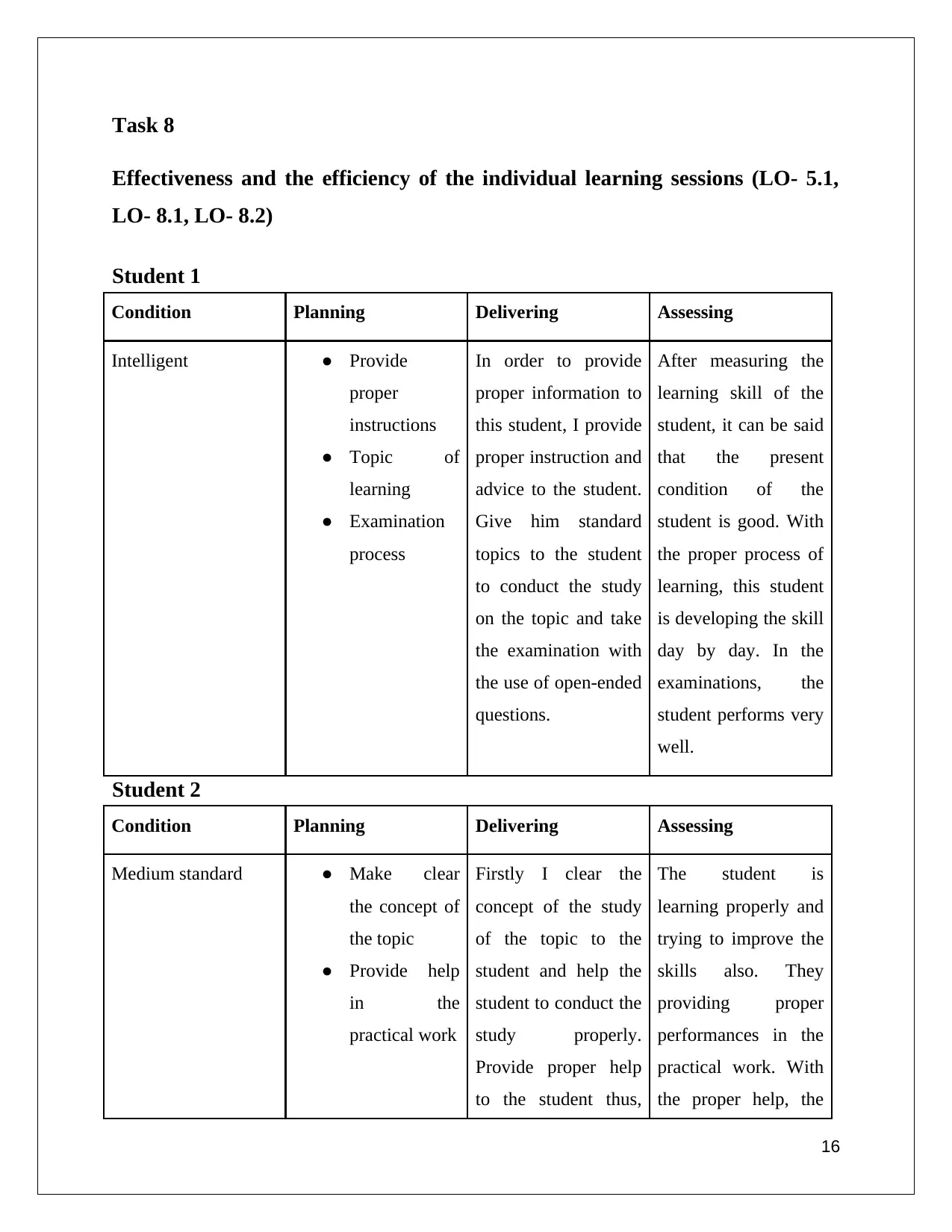
Task 8
Effectiveness and the efficiency of the individual learning sessions (LO- 5.1,
LO- 8.1, LO- 8.2)
Student 1
Condition Planning Delivering Assessing
Intelligent ● Provide
proper
instructions
● Topic of
learning
● Examination
process
In order to provide
proper information to
this student, I provide
proper instruction and
advice to the student.
Give him standard
topics to the student
to conduct the study
on the topic and take
the examination with
the use of open-ended
questions.
After measuring the
learning skill of the
student, it can be said
that the present
condition of the
student is good. With
the proper process of
learning, this student
is developing the skill
day by day. In the
examinations, the
student performs very
well.
Student 2
Condition Planning Delivering Assessing
Medium standard ● Make clear
the concept of
the topic
● Provide help
in the
practical work
Firstly I clear the
concept of the study
of the topic to the
student and help the
student to conduct the
study properly.
Provide proper help
to the student thus,
The student is
learning properly and
trying to improve the
skills also. They
providing proper
performances in the
practical work. With
the proper help, the
16
Effectiveness and the efficiency of the individual learning sessions (LO- 5.1,
LO- 8.1, LO- 8.2)
Student 1
Condition Planning Delivering Assessing
Intelligent ● Provide
proper
instructions
● Topic of
learning
● Examination
process
In order to provide
proper information to
this student, I provide
proper instruction and
advice to the student.
Give him standard
topics to the student
to conduct the study
on the topic and take
the examination with
the use of open-ended
questions.
After measuring the
learning skill of the
student, it can be said
that the present
condition of the
student is good. With
the proper process of
learning, this student
is developing the skill
day by day. In the
examinations, the
student performs very
well.
Student 2
Condition Planning Delivering Assessing
Medium standard ● Make clear
the concept of
the topic
● Provide help
in the
practical work
Firstly I clear the
concept of the study
of the topic to the
student and help the
student to conduct the
study properly.
Provide proper help
to the student thus,
The student is
learning properly and
trying to improve the
skills also. They
providing proper
performances in the
practical work. With
the proper help, the
16
Secure Best Marks with AI Grader
Need help grading? Try our AI Grader for instant feedback on your assignments.
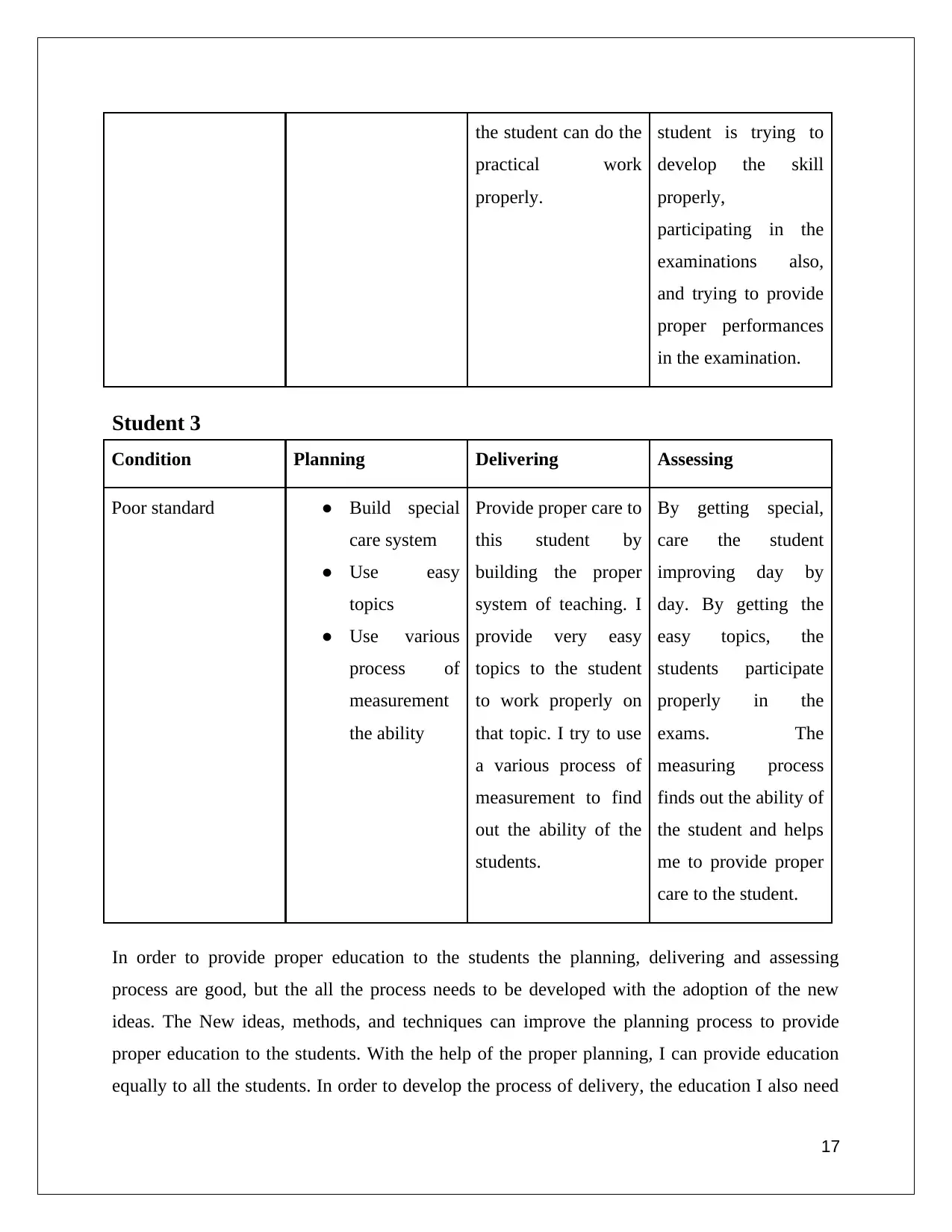
the student can do the
practical work
properly.
student is trying to
develop the skill
properly,
participating in the
examinations also,
and trying to provide
proper performances
in the examination.
Student 3
Condition Planning Delivering Assessing
Poor standard ● Build special
care system
● Use easy
topics
● Use various
process of
measurement
the ability
Provide proper care to
this student by
building the proper
system of teaching. I
provide very easy
topics to the student
to work properly on
that topic. I try to use
a various process of
measurement to find
out the ability of the
students.
By getting special,
care the student
improving day by
day. By getting the
easy topics, the
students participate
properly in the
exams. The
measuring process
finds out the ability of
the student and helps
me to provide proper
care to the student.
In order to provide proper education to the students the planning, delivering and assessing
process are good, but the all the process needs to be developed with the adoption of the new
ideas. The New ideas, methods, and techniques can improve the planning process to provide
proper education to the students. With the help of the proper planning, I can provide education
equally to all the students. In order to develop the process of delivery, the education I also need
17
practical work
properly.
student is trying to
develop the skill
properly,
participating in the
examinations also,
and trying to provide
proper performances
in the examination.
Student 3
Condition Planning Delivering Assessing
Poor standard ● Build special
care system
● Use easy
topics
● Use various
process of
measurement
the ability
Provide proper care to
this student by
building the proper
system of teaching. I
provide very easy
topics to the student
to work properly on
that topic. I try to use
a various process of
measurement to find
out the ability of the
students.
By getting special,
care the student
improving day by
day. By getting the
easy topics, the
students participate
properly in the
exams. The
measuring process
finds out the ability of
the student and helps
me to provide proper
care to the student.
In order to provide proper education to the students the planning, delivering and assessing
process are good, but the all the process needs to be developed with the adoption of the new
ideas. The New ideas, methods, and techniques can improve the planning process to provide
proper education to the students. With the help of the proper planning, I can provide education
equally to all the students. In order to develop the process of delivery, the education I also need
17
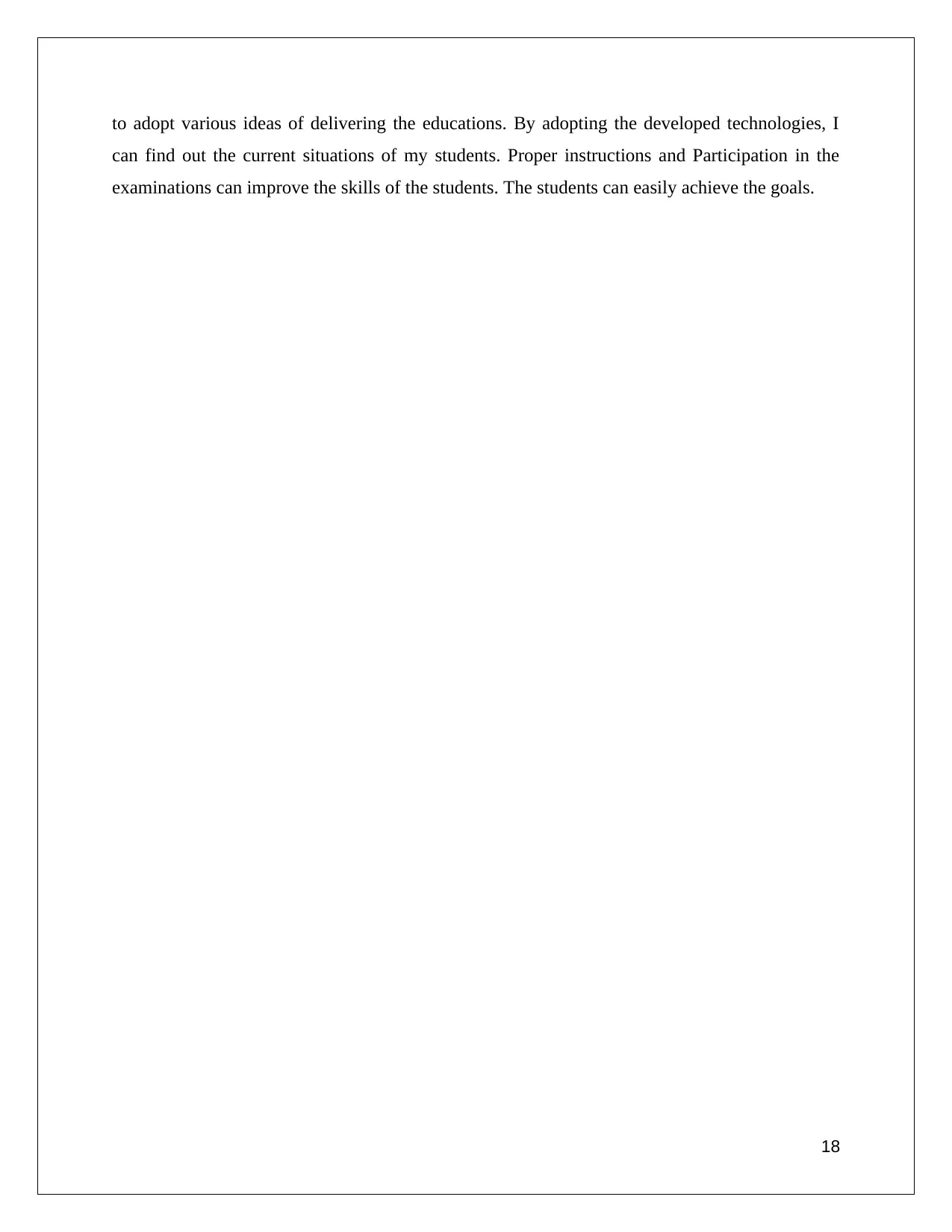
to adopt various ideas of delivering the educations. By adopting the developed technologies, I
can find out the current situations of my students. Proper instructions and Participation in the
examinations can improve the skills of the students. The students can easily achieve the goals.
18
can find out the current situations of my students. Proper instructions and Participation in the
examinations can improve the skills of the students. The students can easily achieve the goals.
18
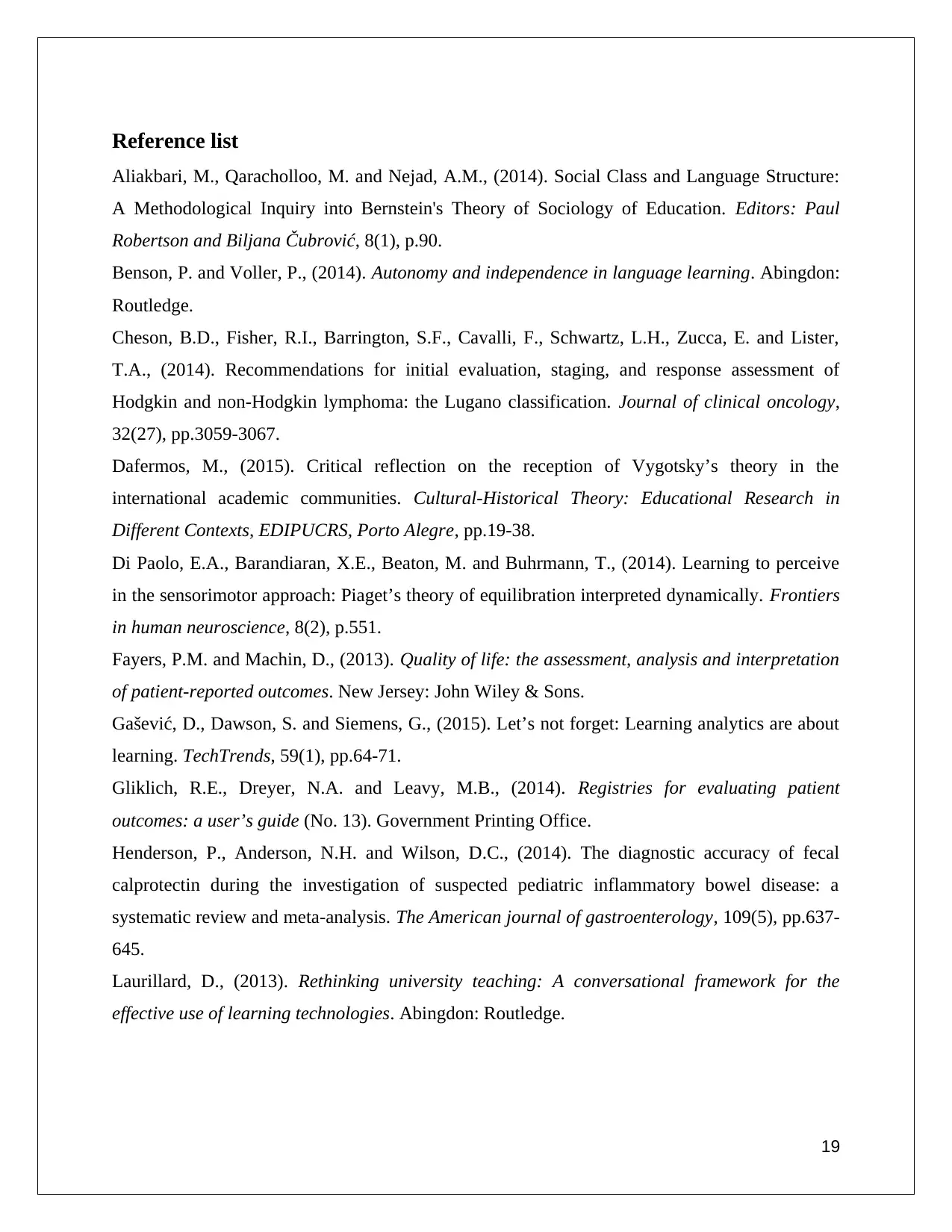
Reference list
Aliakbari, M., Qaracholloo, M. and Nejad, A.M., (2014). Social Class and Language Structure:
A Methodological Inquiry into Bernstein's Theory of Sociology of Education. Editors: Paul
Robertson and Biljana Čubrović, 8(1), p.90.
Benson, P. and Voller, P., (2014). Autonomy and independence in language learning. Abingdon:
Routledge.
Cheson, B.D., Fisher, R.I., Barrington, S.F., Cavalli, F., Schwartz, L.H., Zucca, E. and Lister,
T.A., (2014). Recommendations for initial evaluation, staging, and response assessment of
Hodgkin and non-Hodgkin lymphoma: the Lugano classification. Journal of clinical oncology,
32(27), pp.3059-3067.
Dafermos, M., (2015). Critical reflection on the reception of Vygotsky’s theory in the
international academic communities. Cultural-Historical Theory: Educational Research in
Different Contexts, EDIPUCRS, Porto Alegre, pp.19-38.
Di Paolo, E.A., Barandiaran, X.E., Beaton, M. and Buhrmann, T., (2014). Learning to perceive
in the sensorimotor approach: Piaget’s theory of equilibration interpreted dynamically. Frontiers
in human neuroscience, 8(2), p.551.
Fayers, P.M. and Machin, D., (2013). Quality of life: the assessment, analysis and interpretation
of patient-reported outcomes. New Jersey: John Wiley & Sons.
Gašević, D., Dawson, S. and Siemens, G., (2015). Let’s not forget: Learning analytics are about
learning. TechTrends, 59(1), pp.64-71.
Gliklich, R.E., Dreyer, N.A. and Leavy, M.B., (2014). Registries for evaluating patient
outcomes: a user’s guide (No. 13). Government Printing Office.
Henderson, P., Anderson, N.H. and Wilson, D.C., (2014). The diagnostic accuracy of fecal
calprotectin during the investigation of suspected pediatric inflammatory bowel disease: a
systematic review and meta-analysis. The American journal of gastroenterology, 109(5), pp.637-
645.
Laurillard, D., (2013). Rethinking university teaching: A conversational framework for the
effective use of learning technologies. Abingdon: Routledge.
19
Aliakbari, M., Qaracholloo, M. and Nejad, A.M., (2014). Social Class and Language Structure:
A Methodological Inquiry into Bernstein's Theory of Sociology of Education. Editors: Paul
Robertson and Biljana Čubrović, 8(1), p.90.
Benson, P. and Voller, P., (2014). Autonomy and independence in language learning. Abingdon:
Routledge.
Cheson, B.D., Fisher, R.I., Barrington, S.F., Cavalli, F., Schwartz, L.H., Zucca, E. and Lister,
T.A., (2014). Recommendations for initial evaluation, staging, and response assessment of
Hodgkin and non-Hodgkin lymphoma: the Lugano classification. Journal of clinical oncology,
32(27), pp.3059-3067.
Dafermos, M., (2015). Critical reflection on the reception of Vygotsky’s theory in the
international academic communities. Cultural-Historical Theory: Educational Research in
Different Contexts, EDIPUCRS, Porto Alegre, pp.19-38.
Di Paolo, E.A., Barandiaran, X.E., Beaton, M. and Buhrmann, T., (2014). Learning to perceive
in the sensorimotor approach: Piaget’s theory of equilibration interpreted dynamically. Frontiers
in human neuroscience, 8(2), p.551.
Fayers, P.M. and Machin, D., (2013). Quality of life: the assessment, analysis and interpretation
of patient-reported outcomes. New Jersey: John Wiley & Sons.
Gašević, D., Dawson, S. and Siemens, G., (2015). Let’s not forget: Learning analytics are about
learning. TechTrends, 59(1), pp.64-71.
Gliklich, R.E., Dreyer, N.A. and Leavy, M.B., (2014). Registries for evaluating patient
outcomes: a user’s guide (No. 13). Government Printing Office.
Henderson, P., Anderson, N.H. and Wilson, D.C., (2014). The diagnostic accuracy of fecal
calprotectin during the investigation of suspected pediatric inflammatory bowel disease: a
systematic review and meta-analysis. The American journal of gastroenterology, 109(5), pp.637-
645.
Laurillard, D., (2013). Rethinking university teaching: A conversational framework for the
effective use of learning technologies. Abingdon: Routledge.
19
Paraphrase This Document
Need a fresh take? Get an instant paraphrase of this document with our AI Paraphraser
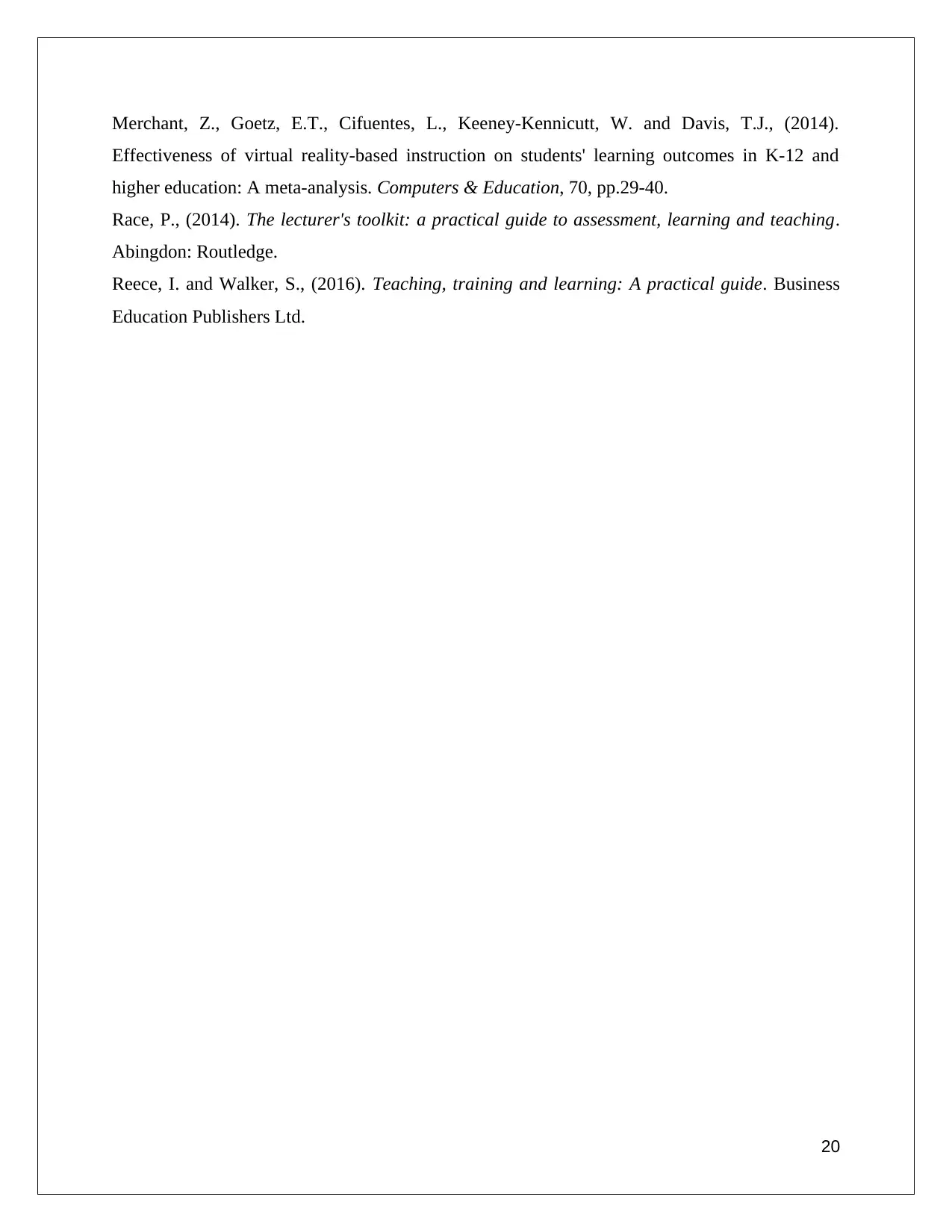
Merchant, Z., Goetz, E.T., Cifuentes, L., Keeney-Kennicutt, W. and Davis, T.J., (2014).
Effectiveness of virtual reality-based instruction on students' learning outcomes in K-12 and
higher education: A meta-analysis. Computers & Education, 70, pp.29-40.
Race, P., (2014). The lecturer's toolkit: a practical guide to assessment, learning and teaching.
Abingdon: Routledge.
Reece, I. and Walker, S., (2016). Teaching, training and learning: A practical guide. Business
Education Publishers Ltd.
20
Effectiveness of virtual reality-based instruction on students' learning outcomes in K-12 and
higher education: A meta-analysis. Computers & Education, 70, pp.29-40.
Race, P., (2014). The lecturer's toolkit: a practical guide to assessment, learning and teaching.
Abingdon: Routledge.
Reece, I. and Walker, S., (2016). Teaching, training and learning: A practical guide. Business
Education Publishers Ltd.
20
1 out of 20
Related Documents
Your All-in-One AI-Powered Toolkit for Academic Success.
+13062052269
info@desklib.com
Available 24*7 on WhatsApp / Email
![[object Object]](/_next/static/media/star-bottom.7253800d.svg)
Unlock your academic potential
© 2024 | Zucol Services PVT LTD | All rights reserved.





